






By Matt Meduri
Suffolk County Comptroller John Kennedy (R-Nesconset) and his team have released the findings of their most recent audit: $6.85 million in misappropriated funds between the years 2016 and 2018 at the hands of several homeless shelters across Suffolk.
Kennedy explained last Thursday at the H. Lee Dennison Building in Hauppauge that seventeen operators misappropriated the near-$7 million by diverting the funds for capital improvements not related to services provided to the homeless population and retroactive salary increases. The $6.85 million makes up just a small percentage of the $107.5 million that the
had received.
By Matt Meduri
When Grumman was the bread and butter of Long Island’s working class, the company produced military aircraft. The Bethpage facility is credited with the construction of the Apollo lunar module, the first crewed spacecraft to operate exclusively in space and, to date, the only crewed vehicle to land anywhere besides Earth.
However, when Grumman ceased its Long Island operations in 1996, it left behind an ecological problem for which Suffolk elected officials and environmental leaders are now sounding the alarm.
The Bethpage site was initially cleared for what became Bethpage Community Park, only for multiple layers of chemical drums encased in concrete to have been excavated after what many believe to be decades.

Continued on page 4

Continued on page 15






Published
by Messenger Papers, Inc.
By Raheem Soto
New Yorkers are fed up. Sky-high taxes, rising utility costs, and a cost of living that continues to climb make it harder for families and businesses to stay afloat. The Metropolitan Transportation Authority (MTA) is now looking for another bailout, pushing to reinstate the full MTA payroll tax to cover its massive budget shortfall.
State Senator Dean Murray (R-East Patchogue) is not standing for it.
Murray, a vocal advocate for fiscal responsibility and small business growth, is taking a strong stand against Governor Kathy Hochul (D) and legislative Democrats pushing for another tax hike. He is urging residents to fight back by signing a petition opposing the payroll tax, which he argues will hurt hardworking New Yorkers while rewarding an agency that has failed to manage its finances.

“We did not mismanage the MTA’s budget—their leadership did,” Murray said. “We are not going to foot the bill for their incompetence.”
The MTA is facing a $33 billion deficit. Instead of fixing its long-standing mismanagement, waste, and fraud, its solution is to demand more money from taxpayers and small businesses.
Wall Street executives or massive corporations will not pay this tax. The MTA payroll tax primarily affects small businesses, entrepreneurs, and workers struggling with New York’s high taxes and soaring costs.
Murray and the New York State Senate Republican Conference have sent a clear message to Governor Hochul and legislative leaders. They are demanding a full forensic audit of the MTA’s finances and the creation of a Financial Control Board to enforce strict oversight and transparency.
“Enough is enough. How can we know how much more is needed when we have not yet identified how much is being wasted?” Murray said. “We desperately need a full forensic audit to uncover how much is lost due to mismanagement, fraud, and abuse. Then, we need a Financial Control Board to take over the MTA’s finances and eliminate wasteful policies. The MTA must clean up its fiscal mess before demanding more money from New Yorkers.”
Raising taxes on businesses has real consequences. When costs increase, businesses cut hours, delay hiring, or relocate to other states. The result is fewer jobs, lower wages, and slower economic growth.
Senator Patricia Canzoneri-Fitzpatrick (R-Malvern) criticized the proposal, arguing that it unfairly burdens taxpayers instead of holding the MTA accountable.
“The MTA’s long history of fiscal mismanagement is in need of real reform,” Canzoneri-Fitzpatrick said. “We must continue to hold them accountable and ensure that taxpayers and businesses are not forced to foot the bill for ongoing failures.”
Senator Rob Rolison (R-Poughkeepsie) added that if Governor Hochul and the MTA want more taxpayer money, they must start improving services.
“If the governor wants to impose another tax on hardworking New Yorkers, we need to see the MTA expand services,” Rolison said. “Especially in Orange County, where commuters do not even have continuous single-seat train rides into New York City for work, medical care, and other essential travel. A return to the MTA payroll tax is not a solution—it is just another burden on the backs of Hudson Valley residents.”
Murray and his Republican colleagues believe the MTA should not receive another cent from taxpayers until it can prove it is managing its budget responsibly.
To ensure financial responsibility, they are calling for two immediate reforms.
First, they want a full forensic audit of the MTA’s finances to uncover waste, inefficiencies, and fraud. This would give taxpayers a clear picture of where their money has been going and whether the MTA has been using it effectively.
Second, they are pushing to create a Financial Control Board to oversee the MTA’s budget. This board would impose strict financial discipline, close budget shortfalls, and implement necessary reforms to put the agency on a sustainable path.
“These are the steps we need to take if we want to restore fiscal integrity to the MTA,” Murray said. “Taxpayers are not an ATM. The days of the MTA treating us like a bottomless source of cash need to end.”
Murray is not just speaking out—he is taking action. He has launched a petition to give New Yorkers a way to voice their opposition to the MTA payroll tax hike.
“This is our chance to send a clear message,” Murray said. “No more blank checks. No more punishing small businesses. No more rewarding failure.”
New Yorkers who want to take a stand can sign the petition on Senator Murray’s official website.
Will Albany Listen?

The Senate Republican Conference is united against this tax increase. Even Governor Hochul has stated that raising taxes should be a last resort. However, many New Yorkers are skeptical, knowing that in Albany, a last resort often becomes reality sooner than expected.
New Yorkers deserve real solutions, not more political games. The MTA’s financial problems are not new, and taxpayers should not be expected to keep bailing out an agency that refuses to reform itself.
You can sign the petition and join the fight by visiting Senator Dean Murray’s official website at https:// www.nysenate.gov/ petitions/dean-murray/ tell-albany-no-mtapayroll-tax-increaseyears-state-budget or by scanning this QR Code:
www.messengerpapers.com
Continued from front cover
Under the New York State Constitution, counties must provide homeless shelters and services. In Suffolk, 79% of shelters are funded by the County; the rest comes from the State.
According to John Imhof (pictured below), Commissioner of the County’s Department of Social Services (DSS), DSS “touches the lives” of over 300,000 residents in a variety of programs, while Suffolk has a homeless population of about 2,400, including over 1,000 children.
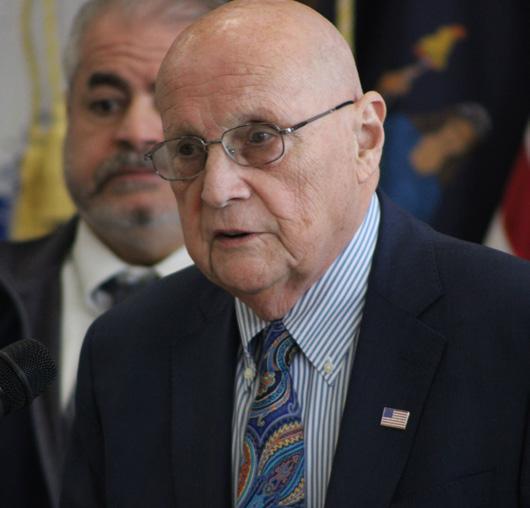
Imhof explained one of the primary ways in which the contractors diverted State and County funds, by not filling beds in the shelters, for which the shelter is paid per filled bed. Shelter residents are typically advised to report back to the shelter before curfew, or risk giving up their bed to the next person on the waiting list. Kennedy, Imoff, and company allege that the contractors would not fill the beds with new arrivals, yet continue to charge the County as if they had been filled.
“There are millions and millions of dollars that were lost during this period of time by open beds,” said Imhoff. “In the meantime, we had waiting lists, and the shelter numbers were increasing. At times, we [the County] were forced to use motels [to house homeless people]. We had to [use motels] because shelter operators were keeping empty beds and charging Suffolk County for them.”
“This [audit] is from 2016 to 2018,” said County Executive Ed Romaine (R-Center Moriches). “When are you going to do the audit from 2018 to 2020, and from 2020 to 2022?” Romaine asked, begging the question of just how much more County subsidies were diverted while pointing to people living in the woods and under highway overpasses.
“This is money that was not spent properly, that we [the County] were charged for, and could have been put towards even more emergency housing and helping more people in need,” said Romaine.
“The findings are more than troubling,” said Comptroller Kennedy, adding they are “outright totally unacceptable” since it was “under the guise of providing service.”
“In some cases, [the operators] acted in an unscrupulous and absolutely unacceptable manner, taking advantage of those in our county who are most at need, most at risk, and, many times, women and children,” said Kennedy, adding that last Thursday’s temperature of twenty-two degrees makes for an even stronger argument for honest budgeting within social services.

Kennedy stated that while DSS “does not have an easy job,” they continue to be an “important partner” in these types of audits, since the homeless housing community can run from small venues with a capacity for just a dozen people, to much larger shelters that can house hundreds of homeless citizens, such as HELP Suffolk in Bellport or CHI in the Hauppauge Industrial Park.
Kennedy said that the biggest aspect of the audit is “disallowances,” wherein “most reputable operators” would find an error or oversight within the budget and report it to DSS and the County to deliberate repayments and maintain solvency.
“When operators acknowledge they have surplus funds but refuse to pay, we disallow. We withhold a portion of their monthly payment and indicate to them that, one way or the other, the money that they took they were not entitled to; they will pay it back,” said Kennedy, adding that disallowed funds go back to the County Legislature to determine where the public funds will go.
“There’s a difference between an innocent mistake and an active attempt to conceal and misappropriate. More often than not, that’s what we’ve found [in this audit],” said Kennedy.
The question now turns to how the County, DSS, and other involved parties can crack down on such instances of fraud. Kennedy and DSS Finance Director Ken Knapp (pictured above) have ideas, such as streamlining the budget process with the State Office of Temporary Disability Assistance (OTDA).
“We have become much more assertive with creating budgets timely for the shelter providers and we are committed to have budgets processed in coordination with OTDA much quicker than it has been in the past,” said Knapp.
“We have a series of recommendations in which we would like to see the contract process strengthened,” said Kennedy, listing the example of simply hiring workers at an agreed-upon salary, only for the shelter to pay the new hire more without DSS approval.
“The operator wants to come back and say, ‘we couldn’t get staff.’ That
may be the case, but they [the shelters] have an obligation to come to the department first,” said Kennedy, adding that retroactive approval of salary increases after a County disallowance “undermines the process” and makes the “RFP [request for proposal] process almost a sham.”
Kennedy also shared that, at the recommendation of his staff, the Comptroller’s office and DSS have moved to a yearly filing basis to eliminate larger time periods where “bad acts” have occurred and could occur. He says this move was in light of “such repeat and large errors” he and his staff have been witnessing.
Several members of the Suffolk County Legislature were in attendance, including Deputy Presiding Officer Steve Flotteron (R-Brightwaters), Dominick Thorne (R-Patchogue), Leslie Kennedy (R-Nesconset), Ann Welker (D-Southampton), Tom Donnelly (D-Deer Park), Minority Leader Jason Richberg (D-West Babylon), and Majority Leader Nick Caracappa (C-Selden) (pictured right)
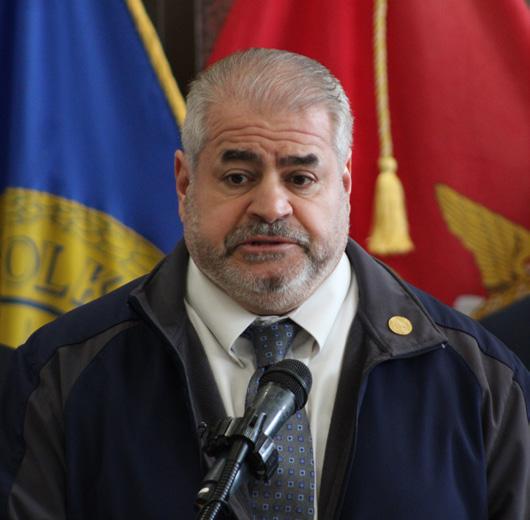
Caracappa shared that while en route to the Dennison Building for the press conference, he had an incident of a homeless woman in need of services under the overpass at Nicolls Highway and Middle Country Road in Centereach. The person in question refuses to go to a shelter because of the bad experience she had a few years ago.
“We tried to explain to her that we have made vast improvements to these shelters,” said Caracappa, adding he’s seen many homeless people in the woods of his district, ranging from those who lost their jobs during the COVID-19 Pandemic and Veterans.
“This is a problem on both sides: the amount of homeless people we have; and those who are running the shelters,” said Caracappa. “The business model was to package many people into these facilities, collect as much money as they possibly can, and provide as little amount of services as they possibly can. That translates to a bad business model and a bad experience for those who are at these shelters.”
Executive Romaine showcased the “watchdog” efforts of Comptroller Kennedy and his staff, sharing that Blue Cross Blue Shield, a former health insurer of municipal employees, was found to have owed the County $1.6 million, which they have agreed to pay back.
Kennedy also stresses that background checks and fingerprinting for shelter employees must remain rigid, owing to a County law that he helped pass during his time in the Legislature in 2004. The legislation was crafted in response to a custodian who was found to be molesting residents at a family shelter.
“We’ve recommended that we expand [background checks] to any individual who has contact within the living area and confines of a facility that needs to be vetted, because they [the homeless residents] are the most vulnerable of the vulnerable we have,” said Kennedy.
“In some cases, the shelters tried to bill the County for reimbursements they were getting from another level, maybe the State; double-dipping, even triple-dipping,” said Kennedy, adding that the County has shut down Nana’s House in Mastic Beach and Project Redirect in Copiague.
“The magnitude of the disallowance got to the point where they would never repay,” said Kennedy. “It was time to shut them down and work with the reputable operators in order to be able to provide the services.”
“Whether it be overcrowding or making residents sleep in poor conditions, it makes me excited to know that we’re going to start going after these bad actors in our community who are not only ripping off the taxpayers, but also victimizing the people that the County is trying to help,” Legislator Thorne told The Messenger, who had several such bad actors in his district. HELP Suffolk, a Bellport-based shelter, was overpaid the most - $2.05 million
“When I took office, I toured the shelters in my district. Many were in great condition, some were in deplorable condition,” said Thorne, referencing open heating vents with rusted metal specifically. Thorne said that shelters without proper safety features, such as smoke detectors, were then told to meet the standards or risk being cut off from County funds.
Thorne, Chair of the FRES Committee and an EMT with decades of experience, added that another problem with some shelters is their straining of emergency resources. A Wading River motel is known to have called ambulances as their “screening process” for new residents, not for actual emergencies.
“If somebody in a shelter needs an ambulance, by all means, activate the 911 system. But you will not use them because you don’t know what else to do with somebody,” said Thorne, referencing a Middle Island case where a resident did not have proper paperwork to enter the shelter, only for the shelter to leave her outside in the freezing cold.
By Raheem Soto
Hey, parents! Looking for something fun (and productive) for the kids to do over winter break?
Well, Suffolk County Legislator Dominick Thorne (R-Patchogue) has just the thing—an exciting Bike Safety Poster and Video Contest that sparks creativity and teaches an essential lesson: how to stay safe on two wheels.
Let’s be real—kids love riding their bikes. It’s a huge part of childhood, offering freedom, fun, and exercise all in one. But with that fun comes responsibility. Every year, too many children get injured in bike accidents that could have been avoided with some simple safety measures. That’s precisely why this contest matters.
Now, before you brush this off as just another school project, hear me out. This isn’t just about making a pretty picture or filming a quick video. The winners will have their work featured by the Suffolk County Police Department as part of their official safety messaging! That means your child’s creativity could help educate others—and that’s pretty cool.
Alright, here’s the breakdown. The contest is split into two categories:
1. Elementary school students can submit a bike safety poster.
2. Middle and high school students can enter a bike safety video.
The deadline? February 28, 2025. That gives your kids ample time to brainstorm, create, and submit their entries.
Where do you send them?
1. Email them directly to DominickS.Thorne@ suffolkcountyny.gov
2. Or, if you prefer, drop them off in person at 90 West Main Street, Suite 2N, Patchogue
It doesn’t get much easier than that!

We live in a time when kids are glued to screens more than ever. Any opportunity to get them thinking about real-world safety—and maybe even outside riding their bikes—should be embraced.
Let’s be honest: bike safety isn’t exactly the most thrilling topic for kids. But when you make it fun and interactive, like this contest does, the message is way more likely to stick.
Think about it—when was the last time your child really thought about bike safety rules? If we’re completely honest, many kids probably hop on their bikes without a second thought about traffic signs, helmets, or riding with traffic. This contest is a simple and engaging way to reinforce those critical lessons.
Need some inspiration for your child’s entry? Here are some simple but vital bike safety rules that can be the foundation for a great poster or video:
1. Ride a properly sized bike. A bike that’s too big or too small can be tough to control, making accidents more likely.
2. Always ride with traffic and obey traffic signs – Just like cars, bikes need to follow the rules of the road. Running stop signs or riding against traffic is dangerous.
3. Keep both hands on the handlebars unless signaling – Swerving, losing control, or struggling to brake are all risks when kids aren’t holding on properly.
4. Look for traffic before entering a street – It’s easy to assume a car isn’t coming, but that’s a dangerous mistake. Always check both ways first.
5. Wear a helmet – This one is not negotiable. A helmet can be the difference between a minor scrape and a life-threatening injury.
These aren’t just good poster ideas—they’re life-saving habits.
Aside from the obvious benefit of learning and spreading an important message, this contest is a fantastic opportunity for kids to showcase their talents.
The poster contest is a chance for budding artists to show off their creativity. Maybe they want to draw a cartoon-style safety guide or a bold, eye-catching reminder about helmets. The possibilities are endless.
For middle and high schoolers who love making videos, this is their chance to get creative with storytelling. They can act out real-life scenarios, make a funny but informative PSA, or even animate their own safety message. Who knows—this could be the start of a future career in media!
And let’s not forget the biggest perk: the winning poster and video will be used by the Suffolk County Police Department in their official safety messaging. That means your child’s work won’t just sit on the fridge—it’ll actually help keep their community safe.
Legislator Dominick Thorne has been a strong advocate for public safety in Suffolk County. This initiative, backed by Resolutions R164-2021 and R1652021, is just one example of how he’s working to keep local families safe.
But this isn’t just about the government doing its part. Bike safety is a community effort. Parents, teachers, and even older siblings all play a role in teaching younger kids how to stay safe.
If you’re a parent, why not take this opportunity to have a conversation with your child about bike safety? Maybe even make a fun family project out of creating a poster or brainstorming a video idea.
At the end of the day, this contest isn’t just about art or filmmaking— it’s about saving lives. If even one child learns something that prevents an accident, then this initiative is a success.
So, if your child has some free time over winter break, encourage them to enter. It’s a fun, meaningful, and potentially life-saving way to spend their time.
And who knows? Maybe they’ll be the next big advocate for bike safety in Suffolk County.
Published by Messenger Papers, Inc.
February 27, 2025
The latest news from Hauppauge is that of an audit conducted by Suffolk County Comptroller John Kennedy (R-Nesconset) and his team, which revealed that homeless shelters in contract with the County and receiving State and County subsidies misappropriated said funds and emphatically did not keep an honest budget.
The scheme is relatively innocuous at face value. Shelters must inform residents of a curfew at which to return to the facility or else risk their bed being given to the next person in line. When shelters did not enforce the curfew, they also did not fill the beds, which allowed the shelters to divert those funds into capital expenditures for work on the facilities that did not pertain to the immediate purveyance of services to vulnerable people. The misappropriations also, allegedly, led to salary increases for some of the workers.
Kennedy explained at last week’s presser that the benefit of the doubt cannot be issued here, as the shelters’ common defenses of being unable to hire more workers - translating to hire salaries for those hired - don’t pan out when they’re contractually obligated to consult with the County on these measures, especially when the County - ultimately the taxpayers - is the party footing the bill.
Likewise, Kennedy detailed that staffing shortages or renovations can be brought to the County’s attention and the needs can then be put on the table. He even said in a half-serious yet half-tongue-in-cheek way, “God put erasers on pencils for a reason,” meaning that mistakes are inevitable, but it’s incredibly difficult to believe that these discrepancies arose from mere clerical errors.
Kennedy said these instances would result in “disallowances,” wherein the County essentially penalizes the beneficiary by cutting funding until the money is “paid back.”
Keep in mind these discrepancies persisted while beds remained unfilled,
while the County subsidized them as if they were occupied, and while homeless Suffolk residents had to find alternative housing or spend a harsh winter or brutal summer night outside in the elements.
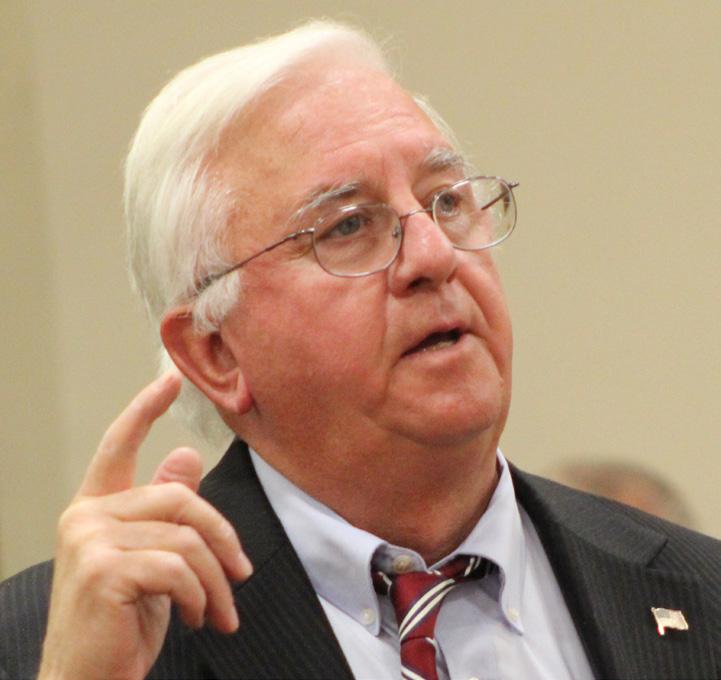
Lack of reporting and cutting corners, however, results in more than just a disallowance, thankfully. Instead, it leads to an audit by our own Comptroller Kennedy, whose team revealed over $6 million in misappropriated funds by multiple shelters from 2016 to 2018.
The Messenger wholeheartedly commends Kennedy and his team for logging what we could imagine as countless hours into running the numbers and serving the books the shelters cooked. County Executive Ed Romaine (R-Center Moriches) campaigned on composing and operating off an “honest budget.” We’re glad to see that vision come to fruition - at least in part - by virtue of the County’s top fiscal watchdogs.
However, the report does not include audits from the years 2018 to 2020 and from 2020 to 2022.
We’re confident in urging Comptroller Kennedy and company to forge ahead with audits of these time periods. We’re not insinuating that he and his team are not willing to do so. We’re simply stating that the team’s actuarial instincts were clearly proven correct and since the audit reports numbers from close to a decade ago, it’s not a stretch of the imagination to surmise these same deals occurred just as recently as 2022.
Regardless of whether subsequent audits on this topic will continue, it’s safe to say Suffolk is in good hands of a fiscal watchdog in Comptroller John Kennedy and his team.
Washington is a swamp—any honest politician will tell you that. It’s full of backroom deals, runaway spending, and lawmakers who talk a big game but fold the minute party leadership tells them to. That’s why Rep. Nick LaLota (R-Amityville) is making waves as one of the most independent Republicans in Congress, refusing to rubber-stamp a budget deal unless it actually works for Long Islanders.
This week, LaLota voted YES on the House’s Budget Resolution, an early step in crafting the federal budget. But before anyone accuses him of being a yes-man for leadership, he made one thing very clear: his final vote on the all-important Budget Reconciliation bill is still up in the air.
Why?

Because when it comes to Medicaid reform and the State and Local Tax (SALT) deduction, the details matter. And if Washington doesn’t get them right, LaLota won’t hesitate to vote against his own party.
Let’s be honest—Long Islanders get crushed by taxes. New York State already bleeds residents dry, and on top of that, the federal government limits how much taxpayers can deduct in state and local taxes. This SALT cap, put in place in 2017, hurts homeowners and middle-class families across the island.
LaLota knows this all too well. Raising the SALT cap is a priority for him because it puts money back in the pockets of hardworking Long Islanders. The numbers don’t lie: In high-tax states like New York, the SALT deduction cap means families pay thousands more to Uncle Sam every year. That’s money that could go toward a child’s college tuition, a mortgage, or keeping a family-owned business afloat.
“I’m committed to ensuring a higher cap that benefits Long Island’s middleclass families,” LaLota said.
Translation? He’s ready to fight tooth and nail to make sure we stop getting shortchanged.
Another issue where LaLota isn’t afraid to ruffle feathers? Medicaid reform. Right now, New York’s bloated Medicaid system is rife with fraud and abuse, and guess who foots the bill?
Taxpayers.
LaLota isn’t calling for cuts to Medicaid itself—he knows many families rely on it. But he does want common-sense reforms to stop taxpayer money from being wasted. That means:
Kicking illegal immigrants off the program –Americans should not be paying for benefits for people who aren’t even here legally. Period.
Requiring able-bodied adults to work or look for a job – If you’re capable of working, you should be contributing to society, not living off government handouts. Eliminating fraud, waste, and abuse – New York’s Medicaid system is one of the most corrupt and mismanaged in the country. Every dollar lost to fraud is a dollar taken from someone who truly needs help. If these reforms aren’t included in the final budget bill, LaLota says he won’t vote for it. That’s a rare level of backbone in Washington, where politicians love to promise “fiscal responsibility” but never actually deliver.
LaLota isn’t afraid to go against the grain, and his record proves it. He was recently ranked the ninth most independent Republican in the House, meaning he doesn’t just vote party-line for the sake of it. Unlike too many politicians who say one thing back home and do another in D.C., LaLota’s votes actually reflect the interests of his constituents.
And that independence might be tested soon. The Budget Reconciliation bill— the one that actually makes the big spending and tax changes—is still months away. The pressure will be on for LaLota to fall in line with the party and vote for it, no matter what’s in it.
But he’s already made it clear: If it doesn’t help Long Islanders, he’s voting NO.
Nick LaLota isn’t just another Republican in Congress—he’s a fighter for Long Island’s middle class. He knows that Washington’s reckless spending and broken policies have hurt hardworking families for far too long. That’s why he’s demanding:
A higher SALT cap to stop overtaxing Long Islanders.
Medicaid reform that removes illegal immigrants, requires work for ablebodied adults, and cuts waste.
Fiscal responsibility without gutting Social Security and Medicare.
If Congress doesn’t deliver on these, LaLota won’t hesitate to say NO—even to his own party. And that’s exactly the kind of leader Long Island needs in Washington.
By Senator Alexis Weik
Originally proposed as environmental protection for New York City, Congestion Pricing has proven itself to be an environmental farse. In the short time this tax has been in place it has become little more than a permit for the wealthy to access city streets while shoveling the masses on to less than safe mass transit.
Why does the MTA even need Congestion Pricing?
In 2009, the MTA Payroll Tax, which promised permanent financial sustainability, was passed by the NYS legislature. It taxes everyone, municipalities, businesses, residents, hospitals and even nonprofit organizations - even shelters for battered women pay the MTA tax and not just once, but always. It appears on your payroll tax and on your property taxes.

When the Governor paused Congestion Pricing, she then started talking about raising the MTA tax to make up the difference. The MTA has been weaponized. The authority is hoping the public has forgotten they already contribute an additional $1.3 billion dollars per year towards their robust $18 billion dollar budget. In fact, the MTA has collected more than $25 billion dollars since its payroll tax went into effect.
Increased tolls at our bridges, increased fares on trains, MTA payroll tax,
and now Congestion Pricing – when does it end? If we keep giving the MTA endless streams of money, when will they ever learn to run efficiently?
These taxes are driving business and families out of New York and it must stop.
Senator Alexis Weik (R-Sayville) has represented the Eighth District in the New York State Senate since 2023, after being redistricted from the Third District, which she represented from 2021 to 2022. Within the Town of Islip, the Eighth District includes Bayport, Bohemia, Fair Harbor, Great River, Islip Terrace, Lonelyville, North Great River, Oak Beach, Oakdale, Saltaire, Sayville, and West Sayville, as well as parts of Bay Shore, Brightwaters, Captree-Oak Beach-Gilgo, East Islip, Holbrook, Holtsville, Islip hamlet, Ronkonkoma, West Bay Shore, and West Islip. The district also includes parts of Babylon and Oyster Bay towns.
Senator Weik is the Ranking Member of the Committees on Civil Service and Pensions; and Women’s Issues; and serves on the Committees on Education; Local Government; Social Service; and Veterans, Homeland Security, and Military Affairs.
The Eighth District office is located at 1 Corporate Drive, Suite GL005, in Bohemia and can be reached at 631-665-2311.
By Kristen Osenga
American innovation is under attack. Across the country, it’s increasingly difficult for startups to protect their inventions from large companies that want to steal them.
It’s up to Congress and the new administration to fix the situation -which will go a long way to achieving the president’s stated goal of boosting America’s global competitiveness.
For small businesses, justice in court isn’t the norm. Pursuing a patent case can cost millions. Smaller companies often can’t afford the lengthy legal battle, leaving them with no choice but to accept their losses or settle for a fraction of what their patents are worth. The practice of “steal now, pay later” -- often dubbed “efficient” infringement -- has become common. But it’s not efficient, it’s predatory.
The crisis traces back to 2006, when the Supreme Court’s decision in eBay v. MercExchange drastically altered patent law. Before eBay, courts granted injunctions to stop patent infringement in 94%-100% of cases in which infringement was found. By 2013, that number had fallen to 72.5%.
Today, many patent holders don’t even request injunctions, knowing the courts will likely allow the theft to continue with the requirement that the violator pay royalties. It would be as though squatters broke into someone’s house and refused to leave -- but instead of throwing them out, the courts allowed them to stay as long as they paid rent.
The impact falls heaviest on small businesses. These pioneers, who receive more patents per employee than large corporations, rarely have resources for drawn-out legal battles. Without the credible threat of an injunction to stop infringement, they struggle to negotiate fair terms with deeper-pocketed competitors.
As American courts have dismantled our patent system, innovation has, not surprisingly, fallen off. China has surpassed the United States in 37 out of 44 critical technologies, from artificial intelligence to quantum computing.
Some in Congress want to make it harder for small businesses.
Representative Darrell Issa (R, CA-48) has introduced the misleadingly named Litigation Transparency Act, which would require patent holders to disclose detailed information about how they fund litigation.
The bill is a tactical weapon aimed at small inventors. Since litigation is expensive, startups rely on external funding arrangements to defend their rights against deep-pocketed infringers.
Disclosure requirements would severely compromise funding relationships. By forcing inventors to reveal information about their financial backing, the Act would expose patent holders and their funders to intimidation tactics. It would make the funders more reluctant to back patent cases, effectively closing the courthouse doors to many small companies.
President Trump wants to strengthen American innovation and global leadership, goals that can be achieved with better IP protections. As a first step, the White House should work with Congress to defeat misguided proposals like the Litigation Transparency Act which would disproportionately harm small businesses.
Second, lawmakers should pass the RESTORE Patent Rights Act. This bipartisan legislation would reestablish the presumption that injunctive relief will be granted in cases of proven infringement, while preserving judicial discretion for exceptional circumstances.
These changes align perfectly with the administration’s agenda. Strong patent rights help small businesses compete against large corporations. Perhaps most importantly, they’re essential to regaining America’s technological edge over China.
It’s time to restore the IP rights that drove two centuries of American innovation -- and with them, our nation’s place as the world’s technological trailblazer.
Kristen Osenga, the chief policy counselor at the Inventors Defense Alliance, is the Austin E. Owen Research Scholar and Professor of Law at the University of Richmond School of Law.
Thursday, February 27, 2025
By Cait Crudden
In response to a series of prison strikes and protests across New York, the Department of Corrections and Community Supervision (DOCCS) has announced strict consequences for correction officers participating in the walkouts. According to the agency, officers who continue striking will have their pay docked for each day they are absent, be classified as absent without leave (AWOL), and lose their statesponsored health insurance. DOCCS has deemed the strikes an “illegal job action,” citing the Taylor Law, which prohibits public employees from engaging in work stoppages.

The strikes, which have erupted in dozens of correctional facilities throughout the state, including in the North Country, are in response to deteriorating working conditions. Correction officers have cited chronic understaffing, excessive mandatory overtime, and policies, such as the HALT Act, that they argue have made their jobs significantly more dangerous. The HALT Act, which was enacted in 2022, restricts the use of solitary confinement and has been blamed for a sharp increase in violent incidents inside prisons.
Recent reports show that assaults on correction officers have surged over the past few years. Officers argue that the HALT Act has emboldened violent inmates, stripped

All are Welcome- Join us for Lake Ronkonkoma History as we move forward with the Legend Project of our Lake

them of necessary tools to maintain order, and created an untenable crisis within state correctional facilities.
The striking officers and their supporters in the state legislature have called for the immediate repeal of the HALT Act.
Governor Kathy Hochul’s (D) administration has deployed the National Guard to staff prisons to mitigate disruptions caused by the strikes. However, critics argue that this measure is a temporary solution that does not address the underlying issues correction officers face.
The National Guard members, while highly trained, are not correction officers and are unfamiliar with the specific challenges of managing prison populations. This action can put the men and women of our National Guard at risk.
Republican lawmakers in the New York Senate and Assembly have voiced strong opposition to the state’s handling of the crisis. They argue that New York’s Democratic leadership has prioritized inmate welfare over the safety of correction officers, leading to an unsustainable and dangerous work environment. Members of the Senate Republican Conference have urged Governor Hochul to take immediate action, and they support repealing the HALT Act.
Family members of correction officers have also joined the protest, calling on state leadership to prioritize prison safety and working conditions. Many fear that the loss of pay and benefits will have devastating effects on their households.
Despite the penalties, correction officers remain resolute in their demands. The New York State Correctional Officers & Police Benevolent Association (NYSCOPBA) has continued to negotiate and advocate for better conditions, even in the face of administrative penalties.
As tensions continue to escalate, all eyes are on Albany to see whether Governor Hochul and Democratic legislative leaders will take corrective action or maintain their hardline stance against the striking officers. For now, New York’s correctional facilities remain at the center of a growing labor and public safety crisis.

By Matt Meduri
After Senator Gary Peters (D-MI) declined to seek reelection in 2026 two weeks ago, Democrats received another blow that further hampers their chances of retaking the Senate next year, which were already virtually nonexistent.
Senator Tina Smith (D-MN) is retiring at the end of her term. Smith was appointed to the seat by then-Governor Mark Dayton (D) to serve the remainder of Al Franken’s (D-MN) term after Franken had resigned after numerous sexual harassment accusations. Smith then won a full term by a comfortable margin in the good Democratic year of 2018.
However, Smith was re-elected by a more narrow fivepoint margin in 2020 in what was considered a long-shot pickup opportunity for Republicans, who have not held either one of Minnesota’s U.S. Senate seats since 2002.
The North Star State has proven to be a white whale for Republicans. It currently boasts the longest Democratic voting streak at the presidential level of any state, having backed every Democratic nominee since 1976. While Republicans had found some success on the gubernatorial and Senate levels since the 1990s, there has been a lack of comfortable margins and decisive majorities in the state legislature.
Prior to the 1940s, there was no Democratic Party to speak of in Minnesota. Since then, however, Democrats have enjoyed most of the political power.
In the current political era, Minnesota represents perhaps the best example of the urban-rural divide and shifts within the country. While the Twin Cities have been reliably blue for decades, its immediate suburbs were Republican strongholds mostly until the Trump Era. However, the southern tier and the Iron Range in the north, as well as a large number of agrarian counties, once solidly in the working-class fold of the party, have trended rightward immensely. The Iron Range still proves to be ancestrally Democratic.
But there’s no indication that that’s where the energy is currently headed and there’s still no guarantee those seats could flip. In short, Democrats must deny Republicans any pickups while making a net gain of four on their own. Even defending all of their seats and flipping North Carolina would produce a 52-48 Republican Senate. That’s not the only shakeup in the Senate though. Senator Mitch McConnell (R-KY), who led the Republican caucus from 2014 until 2025 has chosen not to seek an eighth sixyear term.
McConnell was first elected in 1985, most recently being re-elected in 2020, when he cruised to victory in what Democrats had hoped would be a competitive race. The opposition spent $90 million to McConnell’s $64 million to oust him.
Based on Democratic enthusiasm in 2020, there is some speculation of an engaged race here, although the Kentucky seat is not likely to be at the center of the competitive table. Meanwhile, on the federal level, President Donald Trump (R-FL) has secured another victory for his Cabinet-level officials as the Senate narrowly confirmed Kash Patel (R-NV) to serve as Trump’s next FBI Director. Patel’s nomination was one of the most controversial of Trump’s picks, wherein he and the president are hoping to weed out corruption and determine allegations of past politicization. Patel’s 51-47 confirmation vote was along party lines and saw only two absences.

The concurrent shifts make for a wash in the state’s overall lean, but the Twin Cities and their suburbs have grown and shifted the most to the left, creating a roadblock for Republicans that proves perennially difficult to overcome. However, Democratic margins in statewide contests since the Trump Era have been much thinner than in elections of yesteryear, all while the two parties have shared control of the legislature in recent cycles.
That’s why Smith’s retirement is a problem for Democrats. While they’re still slightly favored to hold the seat based solely on fundamentals, their chances in Minnesota may remain on borrowed time, provided the GOP takes advantage of trends in key areas. At the very least, Minnesota is not the safe bet it once was.
Smith’s retirement prompted Lieutenant Governor Peggy Flanagan (D) to announce her candidacy. 2024 Senate candidate Royce White (R) also announced he’s seeking a re-attempt.
The shakeup complicates Democrats’ already-daunting 2026 map even further. The Party of Jackson must defend a toss-up race in Georgia, along with newly-opened Michigan, while also defending now-open Minnesota and possible sleepers in Virginia and New Mexico, depending on who the respective state GOPs nominate.
Meanwhile, Democrats’ only clear shot at a pickup is North Carolina, which, like Minnesota for the GOP, has been Democrats’ white whale since 2008 - the last year in which they won federal statewide races. If the 2026 environment is similar to 2018, Democrats could realistically contend in Iowa, as well as Maine, Montana, and Alaska as decent targets, and Kansas, Texas, and Florida as possible “sacrificial lamb” targets with the outside chances of upsets.
Finally, Trump’s pick in former U.S. Senator Kelly Loeffler (R-GA) was confirmed by the Senate last Wednesday to lead the Small Business Administration (SBA). She was confirmed in a party-line 52-46 vote with two Republicans not voting.
Lieutenant Governor Antonio Delgado (D) (pictured above) has announced he will not seek re-election to the state’s number-two position alongside Governor Kathy Hochul (D) in 2026.
The unexpected development comes just a week after Delgado called on New York City Mayor Eric Adams to resign, the first such stated opinion from the executive branch on the matter. The move also led a Hochul spokesperson to clarify that Delgado “does not speak for the Governor” on the matter. Delgado told reporters that he “serves with the governor” but not at the “pleasure of the governor.”
Delgado represented NY-19, a Hudson Valley-based district, from 2019 until his resignation to run for lieutenant governor in 2022. The Rhinebeck Democrat flipped the seat from Republican John Faso (R) in 2018.
the 2026 ticket.
“Today, Antonio Delgado finally said out loud what has been obvious for quite some time: he is simply not interested in doing the job of the Lieutenant Governor of the State of New York,” said Hochul’s Communications Director Anthony Hogrebe.
Hogrebe added that Hochul “wishes him the best in his future endeavors.”
The past year has been of particular strain on Hochul and Delgado’s relationship, with the two coming to a head in July, when Delgado publicly called for then-President Joe Biden (D-DE) to suspend his campaign, while Hochul remained committed to Biden’s candidacy.
While New York governors and lieutenant governors are elected on the same general election ticket, they must first win their parties’ respective primaries. Hochul can nominate her own running mate ahead of the primary, or wait for the results of that primary.
Hochul is also gearing up for the campaign trail next year, on Monday having named Preston Elliott, a longtime Democratic strategist who successfully led Governor Gretchen Whitmer’s (D-MI) 2022 re-election campaign.
Suffolk County Executive Ed Romaine (R-Center Moriches) has announced the opening of the grant application process for organizations and nonprofits to receive funds generated by the Tenth Annual Catholic Health Suffolk County Marathon that was held in October. The process of doling out the $129,000 raised will be overseen by the Suffolk County marathon Veterans Grant Committee and the I Run This Island Foundation, Inc.
“Suffolk County is home to the largest Veterans population in New York State and we must continue to do all we can to provide the resources and support our local heroes deserve,” said Romaine. “I thank the many volunteers who made the 2024 Suffolk County Marathon a resounding success as the money raised from the event will have a tremendous impact on our Veterans.”
Since the event’s inception, the marathon has raised more than $1.1 million that has been allocated to more than one hundred local nonprofits who provide various Veterans services, such as Paws of War, Pal-O-Mine Equestrian, Long Island Cares, Beacon House, Island Harvest, and more.
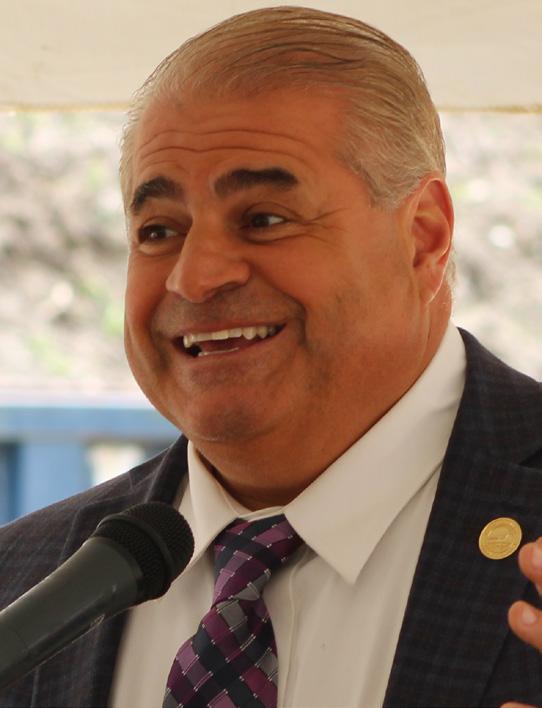
Delgado’s ascension to the ticket came off the heels of Hochul’s original running mate in New York City Comptroller Brian Benjamin (D), who resigned from his office on April 12, 2022, after being indicted with federal wire fraud and bribery charges. The charges were dropped in January 2025.
Delgado’s political future has been somewhat up in the air, with the last few months of 2024 generating speculation around his own gubernatorial bid, meaning he would have had to primary his own boss for the nomination.
“All options are on the table, and I will be exploring them,” said Delgado in a statement of his political ambitions, adding that he remains “determined to be your voice in state government now and in the future.”
A Hochul spokesperson has confirmed that the governor had already been seeking replacements for Delgado on
With the opening of this year’s grant funding application process, even more resources will go directly to these wonderful organizations in efforts to further assist our veteran’s community,” said Majority Leader and Veterans Committee Chair Nick Caracappa (C-Selden) (pictured left). “This has been a very successful partnership between the County Executive’s Office, Catholic Health, Race Awesome, Babylon Village, Law Enforcement, our County Parks Department, and so many more, including the thousands of runners who participate in the Catholic Health Suffolk County Marathon each year. Each step they run or walk is a step closer to providing relief to our veterans. When it comes to serving those who served, Suffolk County doesn’t just Talk the Talk, we Run the Run.”
“We shed light on issues that veterans face after returning from service to include physical disabilities, emotional issues like the signature wound of modern warfare; post-traumatic stress disorder (PTSD), and most important, for those who have lost their battle to suicide,” said Marcelle Leis, Director of the Suffolk County Veteran Service Agency.
Applications are due April 1, 2025, and the application can be found at https:// suffolkcountyny.gov/veterans/Home or by scanning this QR Code at right.
By Cait Crudden
In a concerted effort to enhance emergency response capabilities across New York, Congressman Andrew Garbarino (R-Bayport) has spearheaded a bipartisan coalition urging Governor Kathy Hochul (D) to establish a cooperative agreement with the U.S. Forest Service for the Firefighter Property Program (FFP). This initiative would enable New York’s fire departments to acquire surplus Department of Defense (DoD) equipment, significantly reducing costs and providing critical resources for first responders.
The letter to Governor Hochul, co-signed by Representatives Claudia Tenney (R, NY-24), Mike Lawler (R, NY-17), Nick LaLota (R-Amityville), Nick Langworthy (R, NY-23), Tom Suozzi (D-Glen Cove), Nicole Malliotakis (R, NY-11), and Laura Gillen (D, NY-04), highlights the urgent need for fire departments to obtain and maintain essential firefighting and rescue equipment. While numerous other states have already taken advantage of the FFP, New York has yet to establish eligibility for this vital program.
New York’s fire departments, particularly volunteer and combination agencies, have long faced financial hurdles in acquiring the necessary equipment to effectively respond to emergencies. The FFP, which allows fire departments to purchase or receive donated excess DoD property, presents an opportunity to ease this burden while ensuring first responders are better equipped to handle wildfires, flooding, and other natural disasters.
“Across New York State, countless Fire Departments are struggling to obtain and maintain a variety of necessary fire and rescue equipment given the high costs of doing so. Should agencies be permitted to access this program, it would allow for the sale or donation of excess equipment that can be put to good use by first responders across their communities,” the Members wrote.
The letter emphasizes that many other states have established agreements with the U.S. Forest Service, thereby granting their fire departments access to the program’s benefits. The absence of a cooperative agreement in New York has effectively prevented local agencies from obtaining these valuable resources, leaving them at a disadvantage compared to their counterparts in neighboring states.
Participation in the FFP would have wide-ranging benefits, particularly in bolstering New York’s ability to combat natural disasters. Equipping firefighters with additional vehicles, protective gear, and specialized tools would not only enhance safety for first responders but also improve overall response efficiency during crises.
The letter to Governor Hochul underscores these benefits: “In addition to helping reduce costs for fire departments, participation in this program would also aid departments in becoming better equipped to deal with the variety of emergency situations they face on a regular basis, such as forest fires, flooding events, and other related natural disasters.”
New York’s fire departments play a critical role in disaster response, particularly in rural and suburban communities where resources may be more limited. By securing access to the FFP,
Suffolk County Legislator Jim Mazzarella (R-Moriches) joined Boy Scout Troop 138 on Monday, January 13, to celebrate the outstanding achievements of Carlos Hidalgo and Dayvon Parris at their Eagle Scout Court of Honor ceremony.
“Recognizing two young leaders who have already accomplished such a significant milestone in their lives is truly an honor,” said Legislator Mazzarella. “Attaining the rank of Eagle Scout is a remarkable achievement that only a very small percentage of the population achieves.”
To earn the prestigious rank of Eagle Scout, a Scout must complete at least 21 merit badges, serve in a leadership role within their Troop, and complete an impactful community service project, known as an Eagle Project.
Carlos Hidalgo’s Eagle Project involved designing and constructing a meditation garden at Mary Immaculate Church in Bellport. This serene addition provides a peaceful space for reflection and prayer while enhancing the church property for the enjoyment of parishioners and the broader community.
Dayvon Parris’s Eagle Project addressed a critical community need by organizing a blood drive at Our Savior Lutheran Church in Centereach. His initiative helped replenish supplies at the New York Blood Center, potentially saving countless lives through the generosity of blood donors.
“The journey to Eagle Scout equips young adults with skills and values that will benefit them for a lifetime,” Legislator Mazzarella added. “I look forward to seeing the incredible futures that await these two exceptional young men.”
The ceremony served as a testament to the dedication, leadership, and service of Carlos Hidalgo and Dayvon Parris, inspiring both their peers and the community at large.

these agencies would gain essential tools to better serve their communities and safeguard their lives.
Congressman Garbarino and his colleagues have called on Governor Hochul to take immediate action in forming a cooperative agreement with the U.S. Forest Service. They argue that failing to do so not only places New York’s firefighters at a disadvantage but also limits the state’s overall preparedness for emergencies.
The lawmakers concluded their appeal by stating, “We request that New York enter a cooperative agreement with the U.S. Forest Service so that our state’s first responders can access the same benefits as our neighboring states, providing significant benefits when it comes to enhancing public safety and disaster preparedness and response.”
As the state continues to face increasing challenges posed by climate change, urban expansion, and natural disasters, the establishment of this agreement would represent a crucial step forward in strengthening the capabilities of New York’s fire departments. The bipartisan nature of this effort underscores the universal recognition of the importance of supporting first responders and ensuring they have the necessary tools to perform their life-saving duties effectively.
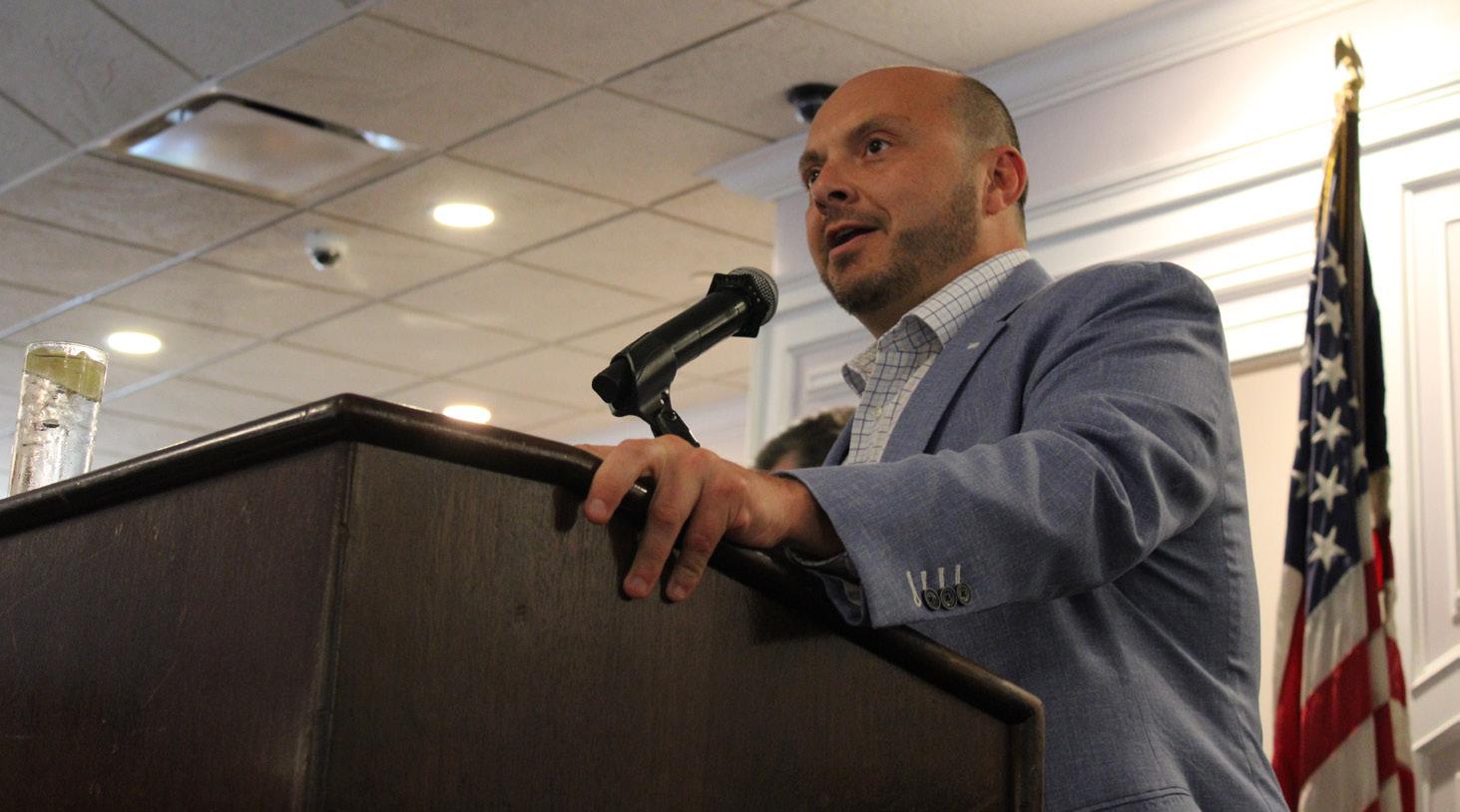

Greek Orthodox Church of the Assumption Sunday, March 9th 9:00am-3:00pm
Organized by the GOYA 430 Sheep Pasture Road
Port Jefferson
Scan QR Code to make an appointment Any Questions call Jennifer 516-310-2382

By Cait Crudden
Congressman Nick LaLota (R-Amityville) (pictured right) reaffirmed his commitment to securing the U.S. border by voting to pass H.R. 35, the Agent Raul Gonzalez Officer Safety Act. This legislation enforces stricter penalties, including the deportation of criminal illegal immigrants, on individuals who evade U.S. Border Patrol within 100 miles of the U.S. border.
“Every executive order signed, and piece of legislation passed pertaining to border security underscores the determined commitment of President Trump and the Republican Congress to secure America’s borders. We are drastically reducing the lethal influx of fentanyl and deterring malicious actors from compromising our national safety,” said LaLota. “My support for the Agent Raul Gonzalez Officer Safety Act, which heightens penalties for those evading our border patrol, solidifies my dedication to strengthening border security, safeguarding our frontline defenders, and ensuring the safety of our communities. Together, we are making America more secure!”
The Agent Raul Gonzalez Officer Safety Act is named in honor of Border Patrol Agent Raul H. Gonzalez Jr. (pictured right), who tragically lost his life on December 7, 2022. Agent Gonzalez sustained fatal injuries while on ATV patrol near McAllen, Texas, in pursuit of illegal migrants evading Border Patrol officers along the Southwest Border.
Under H.R. 35, the following penalties would be imposed on individuals who evade law enforcement within 100 miles of the U.S. border: Two years imprisonment and/or a fine for evading law





enforcement, five to twenty years in prison and/ or a fine if the offense results in serious injury, a minimum of ten years up to life in prison and/or a fine if the offense results in death, as well as, mandatory deportation or inadmissibility for noncitizens convicted of such offenses.
Congressman LaLota has been a consistent advocate for border security, pushing for stronger enforcement measures and legislation to address the ongoing crisis. Actions he has taken previously include co-sponsoring the bipartisan Defending Borders, Defending Democracies Act, requiring the President to secure the U.S. southern border.
The legislation also provided defense-only appropriations to support allies and bolster Taiwan’s defense against potential threats, urging the Biden Administration to enforce existing immigration and border security laws, emphasizing the need for immediate executive action to secure the U.S.-Mexico border, co-introducing the Border Reinforcement Act of 2023 to equip U.S. Customs and Border Protection (CBP) and local law enforcement with essential tools to manage the escalating border crisis. The Border Reinforcement Act emphasizes the need for adequate resources and support to enforce existing immigration laws effectively. He also voted in favor of the Secure the Border Act, which aims to overhaul the broken border security and immigration system. The legislation seeks to enhance the asylum process and provide law enforcement with the necessary support to maintain border integrity.
LaLota’s actions align with broader Republican efforts to curb illegal immigration, reduce drug trafficking, and prevent national security threats. He has repeatedly criticized the Biden Administration’s handling of the border crisis, advocating for stricter enforcement and policy changes to prevent further escalation.

Earl L. Vandermeulen High School is proud to announce that mathematics and computer science teacher Winnifred Kuemmel will be honored with the prestigious Distinguished Teacher Award by the Harvard Club of Long Island. Ms. Kuemmel will be celebrated at the club’s annual Distinguished Teacher Award Ceremony on March 15, 2025, at the Heritage Club at Bethpage.
Each year, the Harvard Club of Long Island selects a select group of outstanding educators after a rigorous selection process, with fewer than 4 percent of applicants making the final cut. Ms. Kuemmel is among the distinguished few chosen to receive this esteemed recognition this year.
Winnifred Kuemmel has been an integral member of the Earl L. Vandermeulen High School faculty since 2008. Throughout her career, she has taught a wide range of courses, including algebra, geometry, and algebra 2, as well as specialized classes such as inclusive eMath, self-contained math, and math life skills. For the past four years, she has focused on advancing the school’s technology curriculum, teaching AP computer science principles, AP computer science A, and an introduction to cybersecurity course.
Beyond the classroom, Ms. Kuemmel has demonstrated commitment to her students’ successes in numerous ways. She served as the head girls’ varsity soccer coach at Port Jefferson from 2010 to 2014, where her leadership led the team to become the Suffolk County Champions in 2012 and the Long Island Champions in 2014. She was also awarded
the Suffolk County Girls Soccer League VIII Varsity Coach of the Year award for three consecutive years (2011–2013).
Winnifred Kuemmel’s impact extends into the realm of extracurricular activities as well. Since 2022, she has served as the advisor for the school’s Hackathon Team, an afterschool computer science club. In this role, she initiated the successful Computer Science Carnival, a schoolwide event designed to engage younger students in the possibilities of STEM education and career paths. With the support of her dedicated afterschool club, the event has become an annual highlight, inspiring students to explore the world of technology.
Ms. Kuemmel’s dedication to mentorship is evident in her work with future educators. Throughout her career, she has mentored two student teachers, both of whom have gone on to secure full-time teaching positions. Her passion for helping others reach their full potential reflects her commitment to educational excellence.
A graduate of SUNY New Paltz with a degree in Mathematics for Secondary Education, Ms. Kuemmel also holds a master’s degree in special education from Saint Joseph’s College. Recently, she earned a computer science certification from the College of St. Scholastica in Minnesota, further solidifying her expertise in the field of technology education. The Earl L. Vandermeulen High School community is thrilled to see Winnifred Kuemmel receive this welldeserved recognition and looks forward to her continued
Wearing purple to mark the day, students across the South Country Central School District took part in P.S. I Love You Day on February 14. The day aims to raise awareness about bullying and suicide while promoting kindness. Students wrote messages of kindness and decorated their schools in purple. At Bellport High School, the student council raised funds for the P.S. I Love You Day organization through the sale of T-shirts.

contributions to education.
For more information regarding the Port Jefferson School District and its students’ many achievements, please visit the District’s website at https://www.portjeffschools.org and follow its Facebook page: https://www.facebook.com/ PortJeffSchools.



On February 14, students from the Bayport-Blue Point High School team sports elective participated in the school’s first bracket-style pickleball tournament to raise awareness and support for the Dezy Strong Foundation. The entire school was invited to attend and cheer on the students and staff as they faced off in this exciting event.
The Dezy Strong Foundation was founded by Matthew “Dezy” DiStefano, who was diagnosed with stage 4 kidney cancer in February 2019 and sadly passed away in January 2020. The foundation is dedicated to helping individuals and families affected by cancer.
In the days leading up to the tournament, students showed their support by purchasing Dezy Strong gear and wearing it on February 13. The tournament, held on February 14, marked the culmination of their efforts to raise awareness for this important cause.

Published by Messenger Papers, Inc.
What do Maya Angelou, Edgar Allen Poe, Gary Soto and William Shakespeare have in common? They are among the famed poets who took a place of honor at Rocky Point Middle School’s annual Poetry Slam on February 13.
The encouraging literary event brought together student readers, teachers and Principal Dawn Meyers to read or recite from memory current and historic works of literature in front of an audience of their peers and teachers in the school library.
Organized by English teacher Sarah Schumacher, the event inspires students to speak publicly, share their likes of particular authors and poets, and to engage in selfexpression with original works of art.
The school congratulates student readers Jennifer Green, Marjorie Hanna, Sarp
Karatepe, Grace Moriarty, Raven Perez, Deborah Saint Surin and Meridith Schmidt and thanks all the students who supported their peers. In addition to Schumacher, teacher-readers were Joe Settepani, Sherin Shanahan, John Schumacher, Tricia Scott and Principal Dawn Meyers.

Miller Place High School students recently showcased exemplary skills and dedication at the Eastern Long Island Regional Science Olympiad on January 25. For the first time in the District’s history, Miller Place had enough students to field two teams at the competition. Team A finished in seventh out of sixty-three teams throughout eastern Long Island, securing them a spot in the New York State Science Olympiad in Syracuse from March 21 through 22.
“We are proud of our students’ hard work in the regional Science

Olympiad,” said Superintendent of Schools Mr. Seth Lipshie. “These students excelled throughout the rigorous competition and represented Miller Place with pride and enthusiasm. We look forward to seeing what they can accomplish at the state competition next month.”
Miller Place had two teams competing in the regional competition in twenty-six challenging categories such as air trajectory, entomology, forensics, wind power and experimental design.
Team A included an experienced group of fourteen students led by Team Captains Lucy Chang and Taylor McHugh. Each member delivered a stellar performance, with senior Bianca Zou winning three medals across four events. The team included seven seniors who won twelve of the team’s eighteen medals.
Team B also showed incredible talent and skill with freshmen Mathilde Snijders and Cate Worcester earning Miller Place two additional medals.
The District congratulates all the Miller Place High School Science Olympiad students and wishes Team A good luck in the state competition next month!
For more information about the Miller Place School District, please visit the District’s website at www.millerplace.k12.ny.us. To read more about the great things happening in Miller Place schools, visit www. millerplaceinthemedia.com and ‘like’ our Facebook page.
The Floyd Academy recently hosted its annual mid-year graduation ceremony to celebrate the fifteen students who officially completed their high school graduation requirements and became the first members of the Class of 2025! The ceremony featured many of the graduates, their families, friends, faculty, staff, administrators, members of the Board of Education, mentorship partners from Stony Brook University and Big Brothers/Big Sisters of Long Island.
“Today we are acknowledging your success – you are a success story,” said John DeBenedetto, principal, Floyd Academy. “This year we talked about creating a vision to guide you in achieving your goals. Today is proof that with a plan, with support and with hard work, you can achieve your goals and achieve your vision.”
At the ceremony, Mr. DeBenedetto invited each graduate up to the front of the room to receive their certificate of completion while he shared personalized highlights about them. He also detailed their future life plans,
which include going to a trade school, attending college, entering the workforce, pursuing a career in nursing, enlisting in the U.S. Marine Corps and more. Mid-year graduates are also invited to walk with the full Class of 2025 at June commencement.
“We are excited for your future – we have witnessed you grow and mature,” said Mr. DeBenedetto. “You are a different person than when you started at the Academy. You now have a new foundation to help you achieve your future goals and dreams.”
Congratulations to this year’s mid-year graduates: Nicholas Allison, Melvin Amaya, Jaden Braun, Diana Gonzalez, Adrianna Hernandez, Nahzavia Jasper, Darian Manzolillo, Matthew McAlonen, Alexis Montanez, Isabella Papaccio, Hannah Perrone, Alif Rahman, Nevaeh Ringgold, Kelvin Rodas Garcia, and Caiden Wilkerson.
Congratulations and best of luck to the graduates!
By Matt Meduri
Like the previous two elections, the path to the White House in 2024 rested almost entirely on the Midwest, specifically the Rust Belt. While 2016 upended norms here, 2024 certainly rewrote the playbook.
The Upper Midwest Battlegrounds
Pennsylvania (19 electoral votes), Michigan (15), and Wisconsin (10) were seen as key to the White House in the last three elections, with Donald Trump (R-FL) becoming the first Republican to win the former two since 1988 and Wisconsin since 1984. Although Joe Biden (D-DE) flipped them back in 2020, the margins were not as robust as they had been for Democrats like Barack Obama (D-IL), John Kerry (D-MA), or Bill Clinton (D-AR).
Although a one-point win is generally considered a close contest regardless of context, Trump’s 1.5% margin in Michigan was somewhat startling, as pundits agreed both in 2016 and 2024 that the Wolverine State would be the most difficult for Trump to flip. It makes Trump’s narrow win relatively large when historic elections are considered.
The election in Michigan also solidified some aspects of a rewritten playbook. Republicans had long owed their support to working-class Kent County (Grand Rapids)ancestral home of Gerald Ford (R-MI). Now, Kent County has shifted to more obdurately blue territory, a statistic that made many believe Michigan to remain a slightly blueleaning state. However, Trump shifted the Detroit area about ten points to the right, winning Muslim-majority Dearborn. The city, also the hometown of the Ford Motor Company, backed Biden nearly 70%-30% in 2020. In 2024, Trump won Dearborn with 42% of the vote, compared to Kamala Harris’ (D-CA) 36% and Jill Stein’s (G-MA) 18%.
This is just a snapshot of two diverging political changes in the state that continue to make it a mixed bag, with Trump’s win in Dearborn being perhaps one of the most surprising results from election night overall. Trump also made sizable gains in counties with considerable black populations, such as Genesee County, home to Flint, as well as Bay and Cass counties.
Harris’ largest gains were in the Traverse City area in the northern reaches of the Lower Peninsula. These gains might be enough to help counter any other gains the GOP might continue to make in the Detroit area.
Trump’s win in Wisconsin produced a statistic that we think is likely to hold going forward. It was the closest state this election, and the only one to be decided by less than one percentage point - a margin of just 0.86%. The Badger State has been decided by such razor-thin margins for the last three elections, with the possibility of this trend continuing to make Wisconsin the bellwether state Ohio once was, wherein the winner of the general election wins the bellwether state.
Trump overperformed across the state, except for Door County, just outside of Green bay, as well as a region called the WOW Counties, with “WOW” standing for Waukesha, Ozaukee, and Washington counties. These three create a collar around Milwaukee and have been historically Republican-leaning suburbs of a Democratic city that hasn’t backed any other party since 1956.
Frequently seen as the bread and butter of the GOP’s strength in Wisconsin, the WOW counties moving towards not only Harris, but to all Democrats in the last three elections makes for a concerning picture for the Republicans here. However, they’ve been able to counter that with massive wins in the south and western parts of the state, home to an ancestrally Democratic dairy farming epicenter. Trump made his largest gains in the state in this region. Wisconsin cannot be classified as moving one way or the other. Perpetual competitiveness and political balance seems to be the state’s modus operandi as of late, opting for a split U.S. Senate delegation and a Democratic State Supreme Court to counter an ironclad Republican hold on Madison.

The greatest baskets of Democratic votes continue to be Milwaukee and Madison, but while they only barely shifted rightward in 2024, a point here and there adds up.
Concurrent U.S. Senate races here saw a staple in Senator Tammy Baldwin (D-WI) only narrowly claim re-election to an opponent seen as an underdog, while Democrats barely held onto the Michigan seat, denying Republicans their first seat from the Wolverine State since 1994.
Finally, in Minnesota, Trump swung all but three counties his way, but not enough to make Minnesota the prime swing state the GOP has been chasing for decades.
Trump’s gains in the agrarian counties of the state were mostly predictable, although his win in Carlton Countypart of the Duluth Metro Area - is the first for a Republican since 1928.
Minnesota has largely been representative of the urban-rural shift in the country, with the southern tier and northern country racing to the right and the Twin Cities suburbs sprinting to the left. Trump failed to crack the Iron Range, a set of counties in northern Minnesota home to one of the most steadfastly Democratic regions in the country, despite many of these Democratic mayors having endorsed him in 2020.
Meanwhile, the Minneapolis-St. Paul area continues to become a massive roadblock for Republicans. While Trump did shift every Twin Cities county to the right, some shifts were practically negligible. Seeing how much bluer the area has become since 2016 offers a clearer picture of the trends.
Harris lost 60,000 votes compared to Biden’s 2020 total, but she still overperformed Hillary Clinton’s (D-NY) narrow 2016 win. The GOP will have to continue its messaging to the Twin Cities suburbs to put the state in their column.
The 2024 election ended much speculation around and solidified the new “red state” statuses of two erstwhile must-win swing states: Ohio and Iowa.
Trump’s sizable wins here in 2016 were seen as both anomalies and flukes, only for him to repeat those margins almost identically four years later, despite losing the election. In 2024, however, he secured both states by double-digit margins, likely ending the regular competition these two industrial Midwestern states once experienced.
Trump’s 11.21% margin in Ohio is the greatest for a Republican since 1988, and the first double-digit result in the Buckeye State since that same year. Only three counties shifted towards Harris, one around the Cincinnati area, and two in the suburban Columbus area.
The greatest shifts to discuss were in the northeastern corner of the state, home to Youngstown and suburban Cleveland. Once the bread and butter of Democrats’ working-class coalition not only in Ohio, but arguably nationwide, the region has fallen completely to Republican control. Mahoning County, home to Youngstown, backed Trump in 2020, voting red for the first time since 1972. Trump has proven the red shift in Ohio is not a fluke, since he won Mahoning by just under ten points last year - a
This column will seek to address the long-forgotten concept of civics and how it relates to American government in general, from the federal level to the local level. This column will explore Constitutional rights, the inner workings of government, the electoral process, and the obligations and privileges of citizens.
previously unthinkable margin for a Republican in generations.
The concurrent Senate race saw Bernie Moreno (R) defeat three-term moderate Sherrod Brown (D). Brown was initially seen as vulnerable, but Moreno was seen as the weakest Republican challenging him. Brown got a sliver of hope when Moreno won the primarying, and the polling went back his way. But Moreno closed the gap by election day and ousted Brown by a comfortable margin. Moreno’s election also showcases the fundamental shifts toward the GOP, as he was able to take Mahoning County and most of northeastern Ohio from Brown, who had won most of the entire region comfortably just six years prior.
Meanwhile, Iowa was a state that the GOP, until 2016, had just become accustomed to losing. Going back to 1988, they were only able to win it once - 2004 - but Trump’s relatively large win of the state in 2016 signalled a possible sea change. While pundits believed the state was within reach for Biden in 2020, it barely shifted leftward.
But in 2024, Trump took the Hawkeye State by 13.2%, the widest margin for any candidate here since 1972. Additionally, he swung all but one of the state’s ninety-nine counties, showing a uniform trend that appears to have changed the political fundamentals.
Home to a variety of farmers, laborers, small cities, college towns, and evangelicals, Iowa was once considered a must-win state. Down ballot, the state can be a bit more idiosyncratic, but the 2024 presidential results show a clear bottoming out of the Democrats’ working-class coalition here.
Emerging Battlegrounds?
The most startling result out of the Midwest was undoubtedly Illinois, a solidly-blue state that hasn’t backed a GOP nominee since 1988 that, on the morning after the election, gave Harris just a four-point lead. That lead later grew to just under eleven points once all votes were in, but the final result still shows a large and concerning shift that The Messenger correctly forecasted in our October 31, 2024, prediction.
Trump’s largest gains were made in Cook County, home to Chicago, and all of its surrounding suburbs. Heavily Latino precincts shifting rightward facilitates this change, begging the question of the GOP’s possible entrance into Illinois going forward. Harris countered with suburban shifts in areas like Peoria, Springfield, and East St. Louis, all gains the Democrats will need if margins continue to shift against them in Chicago.
On the other hand, Democrats’ best bet at a red state becoming blue - or at least purple - is Kansas. The state has shifted the most to the left in the last few cycles out of any other state, owing primarily to Kansas City and Overland Park’s clout and college towns from Kansas City to Topeka. While Wichita remains a Republican-leaning city - Trump improved his margins there - some of Harris’ largest gains nationwide were made in small counties across the state. While a point or two here and there adds up, smaller counties have a lower population base to begin with. It doesn’t mean every county is shifting massively towards her, but it does mean that messaging is sticking in the Sunflower State. Expect Kansas to become competitive over the course of the next decade.
Nebraska also poses a similar opportunity for Democrats, thanks mostly to Omaha, a once solid-red city that is now more predominantly Democratic at the top of the ticket.
Democratic trends in Indiana and Missouri are scattered more immediately outside urban areas, but not enough to push the states into contention. Sporadic gains for Harris across North Dakota and South Dakota are difficult to extrapolate nearby competition in these ruby-red states anytime soon. Otherwise, Trump’s biggest gains were in Native American counties in the Dakotas and Indiana’s portions of Chicago, such as Gary.
Continued from front cover
By Cait Crudden
Now, the former Grumman site in Calverton is in the crosshairs for environmental remediation, as new maps released by the U.S. Navy show “forever chemicals” left behind by the site to be flowing through the Peconic River and significantly hampering water quality for those in northeastern Brookhaven and southern Riverhead.
“The time for action is past due,” declared County Executive Ed Romaine (R-Center Moriches) at last Friday’s briefing at the H. Lee Dennison Building in Hauppauge. “The Navy has not moved forward to protect the residents. They have left their mess; they haven’t cleared their room.”
“Don’t leave us [Suffolk] like you left Bethpage, where even years later, they’re finding drums that you claim never existed,” directed Romaine to the Navy, joined by Suffolk County Legislators Catherine Stark (R-Riverhead), Ann Welker (D-Southampton), Jason Richberg (D-West Babylon), Nick Caracappa (C-Selden), and Steve Flotteron (R-Brightwaters).
Romaine has penned a letter to the U.S. Navy, placing blame squarely on them, but also the New York State Department of Environmental Conservation (DEC), as well as the federal Environmental Protection Agency (EPA). It is Romaine and company’s hope that newly-confirmed EPA Administrator Lee Zeldin (R-Shirley), known colloquially as “Suffolk’s favorite son,” will step in to clean up the toxic chemicals.
“Shame on them!” said Romaine of the Navy, adding that the military branch did not share the information with Suffolk’s Health Department. “This is government at its worst.”
Adrienne Esposito, Executive Director for the Citizens Campaign for the Environment, shared “four main points” to Romaine’s letter to the involved agencies, with the first being the remediation the “forever chemicals,” such as PFAS and 1-4 Dioxane, that are leaching into the Peconic River. These synthetic chemicals earn these names for their inability to be broken down naturally. The Suffolk County Water Authority (SCWA) regularly tests and filters for these contaminants.
“The Navy started their PFAS investigation in 2016. They knew then, due to groundwater samples, that PFAS were in the Swan Pond area,” said Esposito, with Swan Pond just south of the former Grumman site, which flows into the Peconic River. The Peconic River flows west to east, starting in Upton just west of Brookhaven National Laboratory and emptying into Flanders Bay, which opens up into the Great Peconic Bay.
“The Navy spent 2017 and 2018 looking for new sites to test. It has been nine years since they’ve known PFAS are entering into the river and still, there is no remedial cleanup plan,” said Esposito.
Esposito also made mention of the 2023 notice from the New York State Department of Health urging residents to only eat “one fish per month” from the river, with sensitive or immunocompromised individuals urged to not eat the fish from the river at all.
“This was the first PFAS health advisory issued in the history of New York State, thanks to the Navy,” said Esposito.
Romaine and Esposito then shared a harrowing statistic: the actual level of contamination. New York State drinking water standards require that a water source not be polluted more than ten parts per trillion.
The contamination in the Peconic River is two thousand parts per trillion.
Esposito also shared that when she spoke with the EPA only as recently as December did she find out that the EPA moved the standard of water quality safety to four parts per trillion, later increasing it to twelve parts per trillion. Esposito finds the move arbitrary, quoting what the EPA officials told her then, “four times three is twelve.”

The second point of Romaine’s letter is to call for split sampling between the Suffolk DOH and the Navy. Split sampling is when
multiple samples from the same site are taken to separate laboratories for testing.
“In 2024, the Navy didn’t like the Suffolk County Health Department knowing everything, so they stopped splitting samples. That only happens when an agency does something to harm,” said Esposito.
The third point is to urge the federal EPA to reclassify the site from its current Resource Conservation and Recovery Act (RCRA) categorization to a more appropriate “Superfund” site, as part of the EPA’s program to identify, remediate, and return contaminated sites to productive use.
“This will allow for a quick remediation effort and more community input. The State’s [DEC] response has been lethargic, and we need DEC to step up and fight with us,” said Esposito.
The fourth and final point of Romaine’s letter is to ask the Navy for $2 million needed to hook up the rest of the homes on River Road to the public water supply. The number of houses split between Riverhead and Brookhaven towns only amounts to a few dozen, but the community has been trying for years to be hooked up to clean water alternatives. Riverhead Water District Superintendent Frank Mancini is asking for the installation of wells to provide early detections of PFAS moving towards the town’s water wells.
“A food advisory for fish? That’s insane,” said Deputy County Executive Jennifer Juengst. “There are a lot of local people who fish in these waters. To be told to only have one meal a month is alarming. To be told a sensitive person shouldn’t need it at all is twice as alarming.”
Juengst called for “compliance” from the Navy and “long-term monitoring” of the site to ensure remediation efforts, after their implementation, are effective.
Riverhead Town Councilman Bob Kern (R-Riverhead) called the negligence of the site and lack of communication with the Suffolk DOH “criminal.”
“As much as I fault the Navy, I fault more the DEC for not staying on top of the Navy and making sure that this remediation was done properly and expeditiously,” said Kern.
“Exposure to PFAS over long periods of time may lead to adverse health outcomes such as decreased fertility, increased blood pressure in pregnant women, developmental effects for delays in children, increased risk of some cancers, and reduced ability to fight infections,” said Suffolk County Health Commissioner Dr. Gregson Pigott (pictured right).
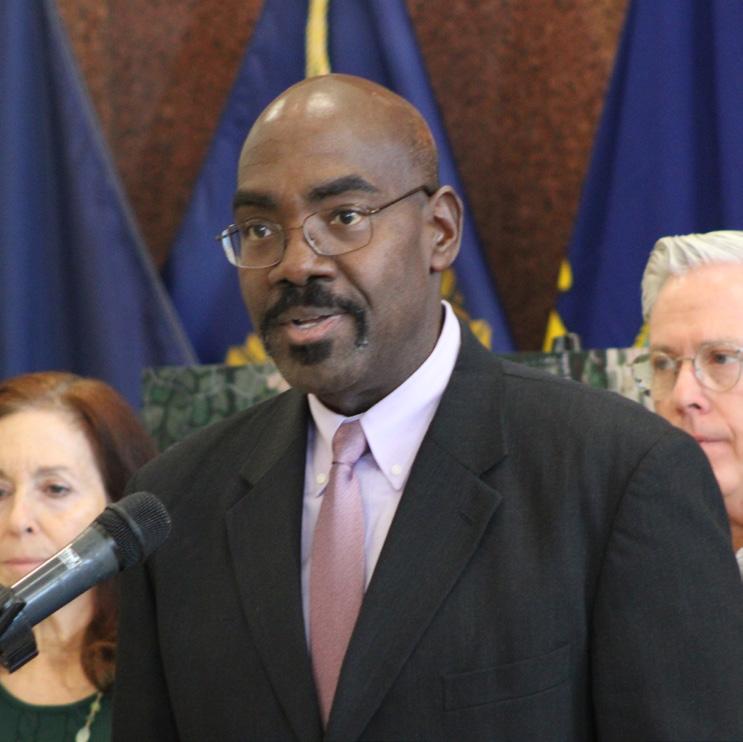
The presser ended with Manorville resident Kelly McClinchy, who has long been an advocate for clean drinking water in the neighborhood of about sixty-four homes. The SCWA has an ongoing project to connect those homes to the public water system.
“The community is paying attention; we’re speaking up, we’re showing up,” said McClinchy, adding that County and Town officials have been steadfast in their efforts to remediate the area. “The community attends the Navy meetings twice a year, and what we get from the Navy is essentially a bunch of lip service. They throw a lot of numbers at us.”
McClinchy (pictured left) said that she and her husband, as well as many in the homes around them, use bottled water for most of their daily activities, but that tasks like bathing and washing dishes make using the contaminated water practically inevitable.
Esposito told The Messenger that, with just some commitment from State and federal agencies, the remediation process could be “relatively easy and quick.”
“It’s not rocket science; they could clean this up. We know how to clean up PFAS. They could cut off the flow before it gets to the concrete. We can clean up PFAS in the drinking water with granular activated carbon (GAC) filtration systems. We do it all over Long Island,” said Esposito.
Thursday, February 27, 2025
By Ellyn Okvist, B.Sc.
“The Ronkonkoma Fire Department, which consists of a hook and ladder company, having no use for any hose, owing to the absence of water hydrants, has been collecting means for their new truck house for some time. The equipments they have already on hand, which they have kept in Mr. O’Connor’s barn, is available for use in case of fire. The Ronkonkoma Fire Department is a very efficient body, its membership is large and well supported by residents and members of the summer colony.”
- The Suffolk County News. August 17, 1906, Page 1, Image 1.

For many years Lake Ronkonkoma had no fire department. Often houses and barns just burned down if they caught fire. Neighbors would help form a bucket brigade if a pond was nearby. In a bucket brigade, a line of people stood shoulder-to-shoulder from the pond or cistern to the building that was on fire. A pail was dipped into the pond and passed from hand-to-hand to the head of the line where the water was tossed on the fire. Then, the person who emptied the pail ran to the pond and filled the pail again, rejoining the end of the line the bucket was passed forward once more. All pails or large pots available were used. In 1903, there was a tragic fire at a section of a resort complex called the Lake Front Hotel. One woman crawled under the bed and was burned to death. Fourteen guests were injured, some jumping from secondstory windows. This incident shocked the town into action, and a volunteer group was formed to fight fires.

The first official notation of the existence of some form of firefighting group was on September 11, 1903, when twenty-four men from the Ronkonkoma and Lake Grove area came together to set the machinery in motion for its formation. Martin A. Metzner was its first president. Other officers included John Campion, vice president; Samuel N. Hawkins, treasurer; and Daniel J. O’Connor, secretary. The geographical boundaries of the Ronkonkoma Hook and Ladder Company, as it was to become known, were described as Nesconset, Centereach, Lakeland, Ronkonkoma, Lake Ronkonkoma, Lake Grove, Holbrook, Holtsville, and Farmingville.

On June 15, 1904, Ronkonkoma Hook and Ladder Company #1 was officially organized with John W. Cleary as its first Chief (pictured right), assisted by John Campion, with Thomas Fish as foreman and Fred H. Wilkinson as secretary. The Fire district, unincorporated, protected a territory of five square miles. Included were what is now known as Sachem School District #5 of Brookhaven Town, and district #11 of Islip Town, with an estimated property value of $369,500. Membership Dues of fifteen cents per month helped support the company. The money for the first truck was raised by the people of the town. It was a horse-drawn vehicle which carried one hundred feet of hose. There were no fire wells or hydrants.

A locomotive tire which resembled a huge iron ring was hit by a hammer as an alarm. It had a distinctive sound which carried for miles and people responded by getting to the point of the fire alarm any way they could. The hammer was chained to the rim so that no one could carry it away. The ring is now on display at the fire house on Portion Road. Originally, it hung between two locust trees on the corner of Portion Road and Hawkins Avenue (pictured left)
Regular meetings of the newly formed volunteer group were held the first Saturday of each month with the annual meeting held in October. The uniforms consisted of a bright red blouse, khaki pants, belt and buckle, and blue fatigue caps. In February 1906, the hook and ladder company were incorporated. Thomas Fish succeeded Chief J.W. Cleary in April 1906. The title for the position was ‘Foreman’ of the department until June 18, 1928, when Joseph Kirk made a motion to change the constitution and by-laws to read ‘Fire Chief’ instead of ‘Foreman’. This motion was seconded and carried. Chief Fish remained in office until May 16, 1938, when he was succeeded by Joseph Kirk.
The minutes of an official meeting of the Ronkonkoma Hook and Ladder Company #1 dated March 19, 1906, states that the annual meeting was held in Goebells Hall. The meeting was called to order by Foreman Fish with eleven members present. Funds to operate the self-support Fire Department from its beginning until the formation of the Fire District came from dues paid by the firefighters, donations and social functions run by the fire department. In addition, income was derived from renting the firehouse to various groups who showed movies or held dances. Local church organizations rented the facilities for their functions. Local history was even made through the use of the building for one of the first radio broadcasts heard in the area. But the most successful form of fundraising came from the firemen’s fairs, which were very popular with the local residents who flocked to them in droves.
On August 4, 1924, the Ronkonkoma Fire Department moved into its new building on Portion Road, and maintained the location until the firehouse was replaced with the existing building. The Lake Ronkonkoma Heritage Association salutes Colonial Flower Shop of Lake Ronkonkoma, for proudly maintaining our “Home of the Original Fire House 1904-1924”. All Information on this page is taken directly from “Spanning the Years 1904-1924 – The Ronkonkoma Fire Department”, Printed by the Review Newspapers, Ronkonkoma; Leo Steidel, Chairman, Ivar Okvist, James Agnew, William Wickers, authors.
1907 parade, Fred Wilkinson and Gustavus DeVere
(Pictured below) Ronkonkoma Hook and Ladder Company, 1904

Published
By Mollie Barnett
Elon Musk’s Grok-3 has emerged as a formidable contender in the AI services market, with a price point that positions itself as a strategic solution for small businesses and independent entrepreneurs. This launch signals more than a product release—it represents a fundamental shift in how smaller enterprises can access and leverage advanced AI capabilities.
Market Positioning and Technical Architecture
Grok-3’s introduction brings several technological advancements that merit careful analysis. The platform’s Think Mode and Big Brain Mode capabilities demonstrate enhanced reasoning frameworks, while its Deep Search functionality introduces an AI-driven approach to information retrieval that could prove particularly valuable for businesses with limited research resources. The offering includes unlimited image generation capabilities on select plans, with voice functionality scheduled for future—both features that traditionally command premium pricing from other providers.
The platform’s pricing strategy reveals a calculated market approach with two distinct tiers: X Premium+ at $50 monthly and SuperGrok at $25 monthly. This positioning offers an accessible AI entry point to small businesses previously priced out of enterpriselevel AI solutions.
Small Business Value Proposition
For small businesses, Grok-3’s appeal extends beyond mere cost considerations. The
platform provides several advantages:
Resource Optimization: Small businesses can leverage advanced AI capabilities without a dedicated technical team or extensive infrastructure. The integrated nature of Grok3’s features combine text generation, image creation, and real-time data analysis - a comprehensive toolkit that would otherwise require multiple subscriptions or significant internal development.
Market Intelligence: The platform’s Deep Search functionality draws from real-time X data and broader internet sources, enabling small businesses to monitor market trends, competitor activities, and consumer sentiment with unprecedented immediacy. This capability could prove particularly valuable for businesses operating in fast-moving sectors or seeking to identify emerging market opportunities.
Content Generation Efficiency: The unlimited image generation feature, combined with advanced text capabilities, allows small businesses to maintain consistent content marketing efforts without straining creative resources. This could significantly reduce the cost and time associated with maintaining competitive digital presence.
Competitive Landscape and Market Dynamics
In the current AI services ecosystem, Grok3 competes directly with established players including OpenAI’s ChatGPT, Google’s Gemini, Anthropic’s Claude, and DeepSeek. While the platform demonstrates competitive advantages in real-time data integration through X and
conversational engagement, increasing scrutiny from industry analysts has revealed challenges in maintaining consistent accuracy across complex business scenarios and ensuring comprehensive ethical safeguards—particularly in cases involving sensitive business data or regulated industries.
Implementation Considerations
Small businesses considering Grok-3 adoption should evaluate several factors:
Technical: The platform’s effectiveness depends on how well it can be integrated into existing business processes. Organizations should assess their readiness and develop clear implementation strategies.
Risk Management: While Grok-3 offers sophisticated capabilities, businesses must establish appropriate governance frameworks to ensure AI-generated content aligns with brand standards and regulatory requirements.
ROI Metrics: Small businesses should develop clear metrics for measuring the platform’s impact on operational efficiency, customer engagement, and revenue generation.
Strategic Implications
The emergence of Grok-3 reflects broader industry dynamics where technological capability intersects with accessibility and practical business application. For small businesses, this development represents an opportunity to access enterprise-grade AI capabilities at a fraction of traditional costs.
Market observers note that early adoption could provide significant competitive advantages, particularly for businesses


operating in digital-first environments or those seeking to optimize resource allocation. However, success will depend on thoughtful implementation strategies that balance technological innovation with practical business objectives.
As the AI services market continues to evolve, platforms like Grok-3 may fundamentally reshape how small businesses compete in increasingly digital marketplaces. The key to success will lie in careful evaluation of capabilities against business needs, coupled with strategic implementation approaches that maximize return on investment while minimizing potential risks.
Mollie Barnett, a Microsoft-certified Generative AI expert and Forbes Communications Council member, brings twenty years of marketing leadership to AI transformation. She specializes in helping SMBs implement practical AI solutions for business, training, and integration, and provides strategic guidance on AI ethics, security and compliance.

By Raheem Soto
Tucked away on Railroad Avenue in Center Moriches sits a small but powerful piece of American history—one that tells a story of resilience, faith, and the pursuit of the American Dream. The Mary E. Bell House, built in 1872, isn’t just another old home preserved for nostalgia; it’s a living testament to the strength of Long Island’s black community and their commitment to faith, family, and freedom.
For over a century, this modest house was a pillar of hope and unity for African Americans in Suffolk County at a time when churches and public spaces weren’t always welcoming to black families. Today, the Mary E. Bell House is a historic landmark, serving as a reminder of how ordinary people can make an extraordinary impact.
The story of the Mary E. Bell House starts with Selah W. Smith, a hardworking farm laborer, and his wife, Mary Ann, a laundress. Like many Americans in the late Nineteenth Century, they worked hard, saved what they could, and built a home for their growing family.
Life in the late Nineteenth Century was a challenging landscape, especially for African Americans striving to establish themselves in communities that weren’t always welcoming. However, the Smiths, far from seeking a handout, were diligently building a better future for themselves and their five daughters, one brick at a time. Their resilience is a testament to the human spirit and a source of inspiration for us all.
Their home wasn’t just a place to sleep at night. It became a gathering place for worship and community meetings, especially when black residents faced obstacles in attending traditional churches. Faith was the backbone of this home, and it remained that way long after Selah and Mary Ann were gone.
Fast forward to the late 1800s. The small African Methodist Episcopal
(AME) congregation in Center Moriches had lost its leader, and the church was struggling to survive. Many would have given up, but Mary E. Bell stepped up.

Mary was a woman of faith, determination, and action. When local churches weren’t available to black residents, she opened her home for worship. Sunday services, prayer meetings, and community gatherings all happened under her roof.
Her leadership and dedication kept the congregation together. And in 1895, when she married Ernest Bell, a hardworking laborer from North Carolina, they continued the mission together. Their home became a spiritual refuge where faith wasn’t just preached but lived.
More Than Just a House—A Symbol of Community Strength
During the late Nineteenth and early Twentieth centuries, the Bell family’s home was seen as a beacon of stability in uncertain times. Jim Crow laws and segregation made life difficult for black families, the Mary E. Bell House stood as a reminder that faith and perseverance could withstand even the toughest challenges.
As times changed, so did the community. In 1914, the AME church in Center Moriches officially closed, leaving a void in the lives of many. But Mary didn’t abandon the congregation—she brought it home. Services, Bible studies, and community events continued in her living room, a testament to the community’s strength and resilience.
And her work didn’t stop there. Mary became a leader in the Varick Christian Endeavor Society, helping young adults in the community build their faith and develop leadership skills that would shape their futures.



Her influence extended beyond church walls. She encouraged self-reliance, education, and hard work, values that have always been at the heart of the American Dream.
After Mary’s passing, her daughter, Alice Bell, carried the torch. She didn’t just maintain the home—she kept its spirit alive.
Alice was known for her generosity and community service, often raising funds for the church through events featuring her legendary sweet potato pies. If you grew up in the area, chances are you’ve heard stories about Alice’s cooking bringing people together just as much as her mother’s faith had.
Through tough times and changing landscapes, the Bell family never lost sight of what mattered most—community, faith, and service.
By the 1990s, Alice had passed, and the house faced an uncertain future. Without a caretaker, it fell into disrepair. Worse yet, it was at risk of being demolished due to tax issues.
But this wasn’t just any house. This was a piece of Long Island’s black history, and the community wasn’t going to let it disappear.
Thanks to local activists, the Bell AME Zion Church, and the Ketcham Inn Foundation, efforts were made to save the home. In 2011, Brookhaven Town officially designated it as a historic landmark. Restoration efforts kicked into high gear, and by 2019, the house was fully restored and reopened to the public.
In 2020, the house earned a spot on the National Register of Historic Places, cementing it as one of Long Island’s most important African American landmarks.
At a time when history is often rewritten or ignored, the Mary E. Bell House is a reminder of the real American story—one of perseverance, faith, and community. It’s about ordinary people making an extraordinary impact.
The house now serves as a museum and event space, educating visitors about the rich history of African American land ownership and faith-based activism in Suffolk County.
But more than anything, it reminds us that the American Dream has never been about handouts or victimhood. It’s about working hard, standing firm in your beliefs, and building something that lasts for future generations.
The Mary E. Bell House isn’t just black history—it’s American history.
And it’s a story worth telling.
If you want to see this incredible piece of history, you can visit the Mary E. Bell House in Center Moriches. It’s a chance to connect with the past, appreciate the sacrifices made, and be inspired by the resilience of those who came before us.
Because history isn’t just about where we’ve been—it’s about where we’re going next.
Published by Messenger Papers, Inc.
Thursday, February 27, 2025
By Betsy McCaughey | AMAC Outside Contributor
How good are voters’ memories? The outcome of the New York City mayoral election may hinge on how much they remember of former Gov. Andrew Cuomo’s corruptionfilled past.
Cuomo is hoping to rewrite his own history and run for mayor. He got a boost Monday when a key Democrat, Rep. Ritchie Torres, called on Cuomo to join the race. “The city is in crisis,” he said.” Torres said he isn’t interested in “relitigating” what forced Cuomo to resign in disgrace in 2021, though Torres was among those who demanded he step down.
Torres may not want to relitigate, but Cuomo’s still in hot water; he got a setback last week, when New York’s highest court, the Court of Appeals, ruled that the state’s ethics commission is constitutional and can proceed with its investigation of a $5.1 million book deal Cuomo made in 2020. He may be forced to relinquish the money.
Cuomo is accused of personally profiting from disaster by having his staff write a book touting his leadership skills during the crisis months of March, April, and May 2020, when nearly a thousand New Yorkers a day, on average, were dying from COVID-19.
The book, “American Crisis: Leadership Lessons from the COVID-19 Pandemic,” was released in October 2020 and soared onto the New York Times bestseller list. Then an avalanche of scandals the following spring tarnished Cuomo, killing the book’s market value.
By then, the state Assembly, controlled by Cuomo’s own party, had initiated an impeachment inquiry. Cuomo’s misuse of state resources to cash in on the book was sufficient grounds for impeachment, a drastic step taken only once before in the state’s history when former Gov. William “Plain Bill” Sulzer was impeached and removed in 1913.
But there were more grounds.
The impeachment inquiry, conducted by the law firm Davis Polk & Wardwell, found “overwhelming evidence” that Cuomo had sexually harassed a female state trooper and several female staff. The inquiry also found that Cuomo had mandated returning COVID-19 hospital patients to nursing homes while they still tested positive, as well as fudging the soaring death toll that resulted.
On Aug. 3, 2021, state Attorney General Letitia James, also a Democrat, issued findings supporting sexual harassment charges from 11 women. A few days later, Cuomo resigned as governor.
Fast-forward to this year’s mayoral race. New York City voters, desperate to halt the crime and chaos destroying their quality of life, are seeking an alternative to the far-left candidates vying for the job.
To explain endorsing Cuomo, Torres pointed to Queens Assemblyman Zohran Mamdani, a member of the Jewish-bashing Democratic Socialists of America, who is also seeking the mayoralty, and said, “We’re confronting a level of extremism unprecedented in the history of New York.”
On Feb. 14, the Staten Island Democratic Party also preemptively endorsed Cuomo. “Andrew Cuomo gets Staten Island,” said party chair Laura LoBianco Sword. “He knows the needs of the outer boroughs.”
Two days later, the Asian Wave Alliance, tired of leftists’ extreme positions, told the New York Post that it’s encouraging Cuomo to run, calling him “the most common-sense candidate.”
“Common sense” or corrupt? As Cuomo’s candidacy becomes a certainty, New Yorkers will need to take a hard look at why Cuomo was deemed unfit for public service by his own party in 2021, and what, if anything, has changed about the man.
Sword said Cuomo “is the only proven leader with the track record of results and resolve to both navigate attacks from Washington and properly address the issues of corruption and deteriorating quality of life our city faces today.” Corruption, Cuomo knows. But Sword’s conclusion suggests how thin the moderate side of the bench is in the Democratic Party.
On Feb. 15, H. Carl McCall, former state comptroller, issued a formal letter urging Cuomo to run. But that’s hardly a sign Black Democrats are united for Cuomo. McCall is 89 years old and far from the party’s standard-bearer.
Overview - AMAC -
The Association of Mature American Citizens
The Association of Mature American Citizens represents Americans 50 plus. AMAC is centered on American values, freedom of the individual, free speech, and exercise of religion, equality of opportunity, sanctity of life, rule of law, and love of family, with benefits at all levels.
AMAC plays a vital role in helping build the services that will enrich the lives of America’s seniors. AMAC Action, a 501 (C)(4) advocates for issues important to AMAC’s membership on Capitol Hill and locally through grassroots activism. To Learn more, visit amac.us
The nonprofit group United for a Better Tomorrow already is running radio ads claiming that Cuomo is nothing but a fair-weather friend to Blacks, citing the times he deprecated former President Barack Obama and McCall.
Last September, Rep. Elise Stefanik grilled Cuomo during a congressional hearing over the “multimillion-dollar” advance on his self-glorifying book. She asked him to stand up and apologize to the families in the room whose loved ones died from COVID-19 in the nursing homes. Cuomo refused.
“There is a reason you are the former governor of New York State,” she seethed. “You will never hold elected office again.”
That depends on how much New York voters choose to remember.



13–
27,




15–Jun 29, 2025 Jul 10–Aug 24, 2025

Etymology:
Middle English: from Old French edifier, from Latin aedificare ‘build’, from aedis ‘dwelling’ + facere ‘make’ (compare with edifice). The word originally meant ‘construct a building’, also ‘strengthen’, hence to ‘build up’ morally.
noun
Pronounced: eh·duh·fuh·kay·shn
Definition: the instruction or improvement of a person morally or intellectually.
Example:
“Please explain this fully for my own edification.”
Synonyms: education, pedagogy, development
Antonyms: ignorance, worsening, regression
Source: Oxford Languages


N C I P O T
See how many words you can create. Must have center letter in word and can use letters more than once. 4 letter word minimum.


See bottom left for the answers (please don’t cheat!)

March 4, 1801: Thomas Jefferson is the first U.S. President to be inaugurated in Washington, D.C.

March 1, 1642: Georgeana, - now York, - Maine becomes the first incorporated city in the American Colonies.
February 28, 1983: Final TV episode of “M*A*S*H”, a 2-hour special directed by series star Alan Alda titled “Goodbye, Farewell, and Amen”, airs (CBS); record 125 million watch in the US
March 3, 1875: Georges Bizet’s last and greatest opera “Carmen” premieres at the Opéra-Comique in Paris, France

February 27, 1708: Slave revolt in Newton (now Elmhurst, Queens) results in eleven deaths





March 2, 1946: Ho Chi Minh is elected President of North Vietnam
March 5, 1853: Piano company Steinway & Sons founded by Heinrich Steinweg (later Henry Steinway) in New York City
By PJ Balzer
This past week, I stood in line next to two strangers in a grocery store that I usually don’t frequent. While there was a few-minute delay up at the register, I was caught in the middle of the two women catching up on life and their adult children’s accomplishments. If I had to take a guess, it would seem like their children were friends when they were young and probably haven’t seen each other in several years. The conversation was simultaneously friendly and distant.
“How is your son doing? We were just thinking about him the other day,” asked one woman to the other.
“Really well. Him and his wife just purchased a beautiful home in an exclusive part of Nassau County. Their kids will be going to a nationally ranked school district. How about your son?”
“It’s been a few rough years honestly, one thing after another. He’s still standing though, we’re really proud of him for that.”
While both women should be equally and extremely proud of their sons’ lives and accomplishments, the second mother’s words stuck into my heart and rang in my head all day, actually all week. As you probably already know, my wife and I have an outreach ministry in a really tough area. We daily see a side of life up close that most people don’t and wouldn’t want to see. We hear life stories and see situations that would cause most people not to be able to sleep at night. For many of the kids we know and love, purchasing a home in an exclusive place isn’t even a thought. Many of them don’t know anyone who has purchased a home; they may not even understand that you’re able to purchase one. Their thoughts are centered around daily survival and fighting through circumstances that fight against them every day, both circumstances outside in their environment and inside their own heart. If they even make it to graduate high school, we consider that a miracle to be celebrated.

will survive. Maybe you’re a parent, like several who I know, who spends much time visiting an incarcerated son or daughter in a correctional facility near the Catskills. You spend more time on a Greyhound bus heading hours upstate or driving alone on those lonely roads, not exactly the future you hoped for and an accomplishment you feel you can brag about. So, I’ll just brag about it for you because I’m proud of you for staying standing and not giving up on your child.
There are people whose spouses have been sick most of their married lives, others who may feel like they may have married the wrong person. There are families who have unspeakable struggles behind closed doors and inside the heart’s deepest corridors. Maybe just this morning you were considering giving up, raising the white flag, and throwing in the towel. You’ve even started entertaining the thoughts of giving up on this life completely. I’ve been there. Yet by no way of random coincidence did you pick up this paper and find me here writing to your heart.
I’m proud of you for still standing and fighting, even though the mountain you’re facing seems immovable. Maybe you’re fighting for your sobriety, your sanity, and your life. You’re only standing to fight because you have children looking up to you and people who rely on you, while you may feel staying standing could never match up to some of the noteworthy accomplishments of others.
Someone is praying for you and proud of you. Don’t you give up now.
All day, after standing in the middle of the women’s conversation, I couldn’t help but think of how many people who may need to hear that someone is proud of them simply for still standing. Starting with a friend of mine who has a child, now a teenager, with a rare skin disease that affects his body inside and out. His entire body is covered in a burn type of rash that needs constant care and monitoring. This rash affects the inside of his body as well, specifically his esophagus and trachea. He spends much time flying around the country to medical specialists who run tests and perform procedures to keep the rash at bay, all while just trying and, of course, desiring to be a regular teenager. His mom has a constant stock of adult diapers, bandages, creams, and other medical items on hand. She’s constantly caring for her son; much of her life is centered around his condition. She’s still standing though, and so is he. As a matter of fact, they are one of the most thankful, compassionate and generous families that I know. I’m really proud of them for not only remaining standing but also being an example to us all.
Another friend of ours has an elementary school child with autism. While she undoubtedly loves her child immensely, the challenges they face as a family on a daily basis are definitely just as immense. Her entire day and, ultimately, her life have to be planned around his schedules, struggles, likes, and dislikes, something I’m sure she never planned for and didn’t dream up for her life. Her home can quickly switch from seemingly quiet to cursing and throwing items around simply because the ice cream man didn’t pass by on time. Our friend, amongst others, we know with children on the spectrum have rearranged their lives and fully embraced this role that doesn’t seem like a grand accomplishment to the casual onlookers or society as a whole: the role as a mom of a child with autism and everything that comes along with that. I’m really proud of her though for that wonderful accomplishment.
Maybe you’re reading this and you’re also just barely standing. Maybe your children or grandchildren are struggling. You’re in a season of life where you spend more time in hospitals than at home. Maybe you’re a person whose job is suddenly in jeopardy, or recently cut, and you’re wondering if your marriage

By Matt Meduri
When Albert Bouchard, his brother, and their friends formed the Blue Öyster Cult in Stony Brook in 1967, they didn’t expect to leave such a lasting legacy, not only by means of inspiring countless other bands after them, but also by producing the source material for perhaps the most iconic line in sketch comedy history:
“I’ve got a fever, and the only prescription…is ‘more cowbell.’”
The famous line was uttered by Christopher Walken on Saturday Night Live’s (SNL) April 8, 2000, episode. The sketch, starring Chris Parnell, Jimmy Fallon, Chris Kattan, Horatio Sanz, and, of course, Will Ferrell, poked fun at one of the rock band’s most famous songs, “(Don’t Fear) The Reaper,” and its peculiar use of an un-rock-like instrument that would define American pop culture forever going forward.
Original Blue Öyster Cult drummer and percussionist Albert Bouchard visited the Long Island Music and Entertainment Hall of Fame (LIMEHOF) in Stony Brook on Saturday to discuss the origins of the band, the legacy of the SNL sketch, and the lasting cultural impact set by both the sketch comedy show and the Stony Brook-based rock band.
Bouchard was born in Upstate’s Jefferson County, growing up in New York City, before moving to St. James in his youth. He describes being “hooked on music” from an early age and even having the ambition to start a band while in high school. While at college, Bouchard met future member Bruce Abbott, who shared the vision of forming a band.
With their first band house in St. James, Bouchard recounts rock critic Sandy Pearlman overhearing one of their jam sessions at Stony Brook University - the band was called Soft White Underbelly at the time. The original roster consisted of Bouchard on drums, Don Roeser on guitar, Allen Lanier on keyboard, Les Braunstein on lead vocals, and Andrew Winters on bass.


The band was given their debut performance as Steve Noonan’s backing band at the SBU gymnasium. Pearlman managed the band and later got them a record deal with Columbia.
The band its ultimate name from Pearlman’s poetry, wherein the “Blue Oyster Cult” is a group of aliens who were secretly guiding Earth’s history.
Bouchard recalls Don Roeser - professionally known as Buck Dharma - pitching him the famous guitar riff that would serve as the iconic opening to “(Don’t Fear) The Reaper.”
“‘This is great, Don! This is going to be a hit!’” Bouchard recalls telling Roeser.
Bouchard left the band in 1981, taking a series of odd jobs while working on other musical endeavors. He later landed a gig teaching in New York City, a position he had held for thirty-one years. Between the royalties from his music, particularly those from “(Don’t Fear) The Reaper,” and his teaching pension, Bouchard (pictured right) says the living he’s made off of his careers has been “substantial.”
The Story Behind the Cowbell
Despite “(Don’t Fear) The Reaper’s” iconic feature of the cowbell, Bouchard says that many of their songs featured the instrument, but that he himself was never the player of the cowbell. That role typically belonged to Eric Bloom. After rejecting a proposed trumpet solo, Bouchard pitched the idea of a triangle to accent parts of the song’s bridge. He described the song as being composed entirely of eighthnotes, relatively faster musical phrases, but in a way that the parts, such as the guitar riff, the bass line, and the busy drum beat.


“I remember clearly, I said, ‘can you turn that down a little bit more?’” Bouchard said of the track containing the cowbell.
“‘Just leave it like that so you can actually hear it,’” Roeser replied to Bouchard.
Bouchard demonstrated the sound of the cowbell to the intimate gathering of about fifty people who claimed seats at LIMEHOF. While the cowbell he used was not the one used in the recording - that one belonged to David Lucas - Bouchard brought along the original timpani mallet with which he played the cowbell for the recording.
Despite the story, friendly disputes still remain as to who actually played the cowbell in the original recording, with David Lucas staking his claim, as well as Eric Bloom.
“It doesn’t really matter who played the cowbell,” Bouchard told LIMEHOF attendees.
The band members had no prior knowledge of SNL’s intention to use their song for the basis of what would become one of their most iconic sketches. Bouchard recalls the night he came excruciatingly close to seeing the skit performed live, when he instead watched a public access benefit produced by David Roter, a songwriter long associated with Blue Öyster Cult.
“He [Roter] had just had his first child. He said he was going on public access TV and wanted to lip sync to a track that we had recorded,” said Bouchard, adding he made a TV mix for the special - an instrumental track without the vocals.
“I had Saturday Night Live on, they said tonight’s special guest was Christopher Walken, and it looked like it was going to cut to a commercial, but it was actually another skit,” said Bouchard, referencing a common trope of fake, humorous commercials on the program. “I didn’t realize that, so I switched to the public access channel and watched David, who had his child with him.”
Bouchard didn’t learn until the next day what SNL had produced. When he had heard the skit was specifically about the music, he thought it was going to be “horrible.” But when he watched the skit, he immediately identified with it.
“I thought, ‘This is so funny, this is just like what happened! How did they even hear the cowbell?’” said Bouchard. “And to this day, I cannot watch it without smiling.”

The breakthrough in this regard was made by David Lucas, an NYC-based producer, composer, and jingle writer, who posited a part of “just quarter notes.” Eighth notes are half the numeric value of quarter notes in music theory. While tempo changes just how quickly these notes are played, quarter notes will always be longer in duration than eighth notes. Lucas’ logic was to cut the business of the song with a straightforward beat.
Bouchard recounts playing the cowbell to Lucas’ suggestion, with Lucas saying, “It’s a little too much,” slightly different than the SNL skit’s, “distracting.” Lucas suggested Bouchard put tape around the cowbell to mute it to make more of a woodblock sound, which is ultimately what ended up in the famous recording. Lucas’ added logic consisted of a heartbeat- pulse-like rhythm that added some subtle intensity to a song about not fearing death.
Bouchard points out that the cast members, while dressed to look like original Blue Öyster Cult members, were not at their correct instruments for what the skit implied. Bouchard also confirmed that Gene Frenkle, the character played by Will Ferrell who is responsible for the cowbell in the skit, does not exist.
Interestingly, Bouchard has never met Will Ferrell, but he hopes to at some point.
One-on-One with Albert Bouchard
While Bouchard lives in Queens, he makes regular trips to PatchoguePerabell being one of his favorite spots - and the Jazz Loft in Port Jefferson, keeping his Suffolk roots intact. He describes all of his six siblings as musically inclined, due to his mother’s penchant for music.
“She used to write songs with her brother and play the piano, so I think that’s where we got it,” Bouchard told The Messenger. “She had an extensive record collection: Bing Crosby, Benny Goodman, that kind of stuff,” Bouchard added, owing to his fondness for jazz. Bouchard’s mother worked for the FBI and later the Chicago Crime Commission.
“We all play. Every two or three months, we have a family jam with our cousins and friends. We’ll get thirty people there,” said Bouchard, primarily of his siblings.
In terms of classical and piano inspirations, Bouchard “always liked” Chopin, Tchaikovsky, and Beethoven.
“I just love how Beethoven broke the rules. Beethoven and Duke Ellington are my two favorite composers,” said Bouchard.
Of current artists, Bouchard says he’s a fan of Coldplay, Tom Bukovac, Rolling Quartz, and even Taylor Swift.
“I love Taylor Swift! She’s my favorite. She wore a Blue Öyster Cult t-shirt; her dad’s a fan,” said Bouchard.
Bouchard remarked on the honor of being at LIMEHOF and being a part of the organization.
“Everybody’s like, ‘how come you’re not in the Rock and Roll Hall of Fame?’ I don’t really care about that, because to me, rock and roll is a subjective classification anyway. It’s not all rock and roll there,” said Bouchard. “This [LIMEHOF] is about music and entertainment; it’s exactly what it is. It’s properly named and you have the real people. It’s not just a popularity contest. It’s people that really made a difference who are from Long Island.”
“The cowbell riff worked, the cowbell skit works, the song works; it’s all about making people feel good,” concluded Bouchard.
Bouchard’s original drum set from the six Blue Öyster Cult records is on display in the upstairs museum at LIMEHOF.
By Ashley Pavlakis
The Colonials are back at it again, this time on the mat as the varsity boys wrestling team showed out at the League I championship earlier this month. The boys took home a second- place finish as a team and piled on other accolades to finish the day.
The varsity squad is led by head coach Tony Mecca, a decorated coach in his fifteenth season at the helm for William Floyd. The Colonial alum was inducted into the school’s Hall of Fame in 2010 for his outstanding contributions as a student-athlete. In addition to coaching boys wrestling, he has also coached football, soccer, softball, and lacrosse. Some might say he’s a well-rounded individual. Wrestling has been a staple in his life for a long time as he’s given thirty-six years to coaching the sport.

The Colonials are members of the New York State Public High School Athletic Association and compete in League I. Assistant coaches Brandon Croteau, Cosmo Stoia, Michael Murtha, and Ray Passaro coach alongside Mecca.
The League I championships took place earlier this month with the Colonials showing out all over the mat. The squad produced multiple winners on the day as they came home with two League I champions in Jayvyn Johnson and Josiah Lors. In addition, they had four second-place winners in David Barrera, David Gonzalez, Aaron Land, and Jack Meyer. Third place saw two winners in Antonio Martin and Rob Martinez. Additionally, in fourth place the Colonials had Caleb Holmes and Ryan Murtha.
The Colonials sent the ten wrestlers who qualified for County Championships to the meet that took place over Valentine’s Day weekend. Junior Josiah Lors claimed the Section XI title in the 215-pound final with an 8-1 decision over his opponent from Bay Shore High School in Joshua Hollman-Pollonais. Lors win was a first for the Colonials as they had not brought home an individual winner in 20 years. With the win, Lors will move on to States which is set to take place at MVP Arena in Albany this weekend.
Jack Meyers, a junior who is set to graduate next spring, notched his 121st career win on February 16. The honorable feat of 100 wins occurred last December and Meyer kept the win train moving with no signs of stopping. Meyer is no stranger to the mat as he’s wrestled in tournaments in and out of New York State for quite a few years now. More often than not, Meyer is the one with his arm being raised to signify the winner post-match. The seasoned wrestler is currently ranked seventh in William Floyd history in career wins. Meyer recently received the Spartan Award, which is given annually to the most outstanding wrestler in Suffolk County. Meyer was also tasked with the honor of being the flag bearer at the county championships. Wrestling is just one of the various sports the William Floyd Colonials are good at. The boys did their job on the mat this season, winning multiple tournaments throughout the year.
The Colonials bleed Floyd green day in and day out.



By Matt Meduri
The Lake Grove Shopping Center is now home to a new Long Island arrival: Wegmans.
Founded in 1916 in Rochester, the privately-held supermarket chain currently has 111 stores in eight states along the east coast. Wegmans has also made consistent appearances on Fortune’s annual “100 Best Companies to Work For” list since the list’s inception in 1998. The company has ranked in the top-four and top-six of the list in recent years.
Hundreds began queuing up at 6:30a.m., with some arriving as early as 3:00a.m., wrapping around the western corner of the store along Moriches Road. Occupying the former site of Lenscrafters, Toys ‘R’ Us, and Babies ‘R’ Us, the 101,000-square-foot store’s block in the strip mall was purchased outright by the grocer. Wegmans paid $15.3 million for the 8.5 acres from Prestige Properties & Development. The latter continues to own the rest of the plaza. The store coexists with Ashley Furniture Home Store, and DSW.
The massive store boasts its own impressive architecture, complete with a clock tower on the northwestern corner of the structure.
But the interior is where Wegmans is truly set apart from your average grocer.

Taking a right turn from the main entrance leads to a large sprawl of counters and stations - over 10,000 square feet worth. While it does consist of the classic staples, such as a bakery and a deli, Wegmans offers a more comprehensive spread. Separate counters serve as stations in a food court, serving fresh, ready-made food, including a butcher counter, pizza, subs and sandwiches, fresh cheese, fresh fruit, fish, sushi, and bowls - the last of which can include meats, vegetables, and other fixings. Separate counters also offer coffee, as well as self-serve bars with Asian cuisine, wings, vegetarian meals, and salads.
Wegmans also has an in-house florist in the center of the store.
Apart from its unique offerings, Wegmans offers a sprawling selection of everyday home items and foodstuffs, along with plentiful self-checkout kiosks and an eighty-six-seat cafe.
“I came here today because Wegmans actually mailed me a brochure with the most beautiful pictures. That was intelligent,” Elizabeth, of Westhampton, told The Messenger. “It’s beautiful and it’s very complete.”
Elizabeth can easily see herself making the Lake Grove location her primary grocery shopping location.


“I think the prices and the quality of the food are very good. There’s also a lot of help in the store,” Elizabeth added, referencing the 500-strong workforce staffing Wegmans. “I like that they have a lot of self-checkout so that, most of the time, you probably won’t have to wait.”
“I’ve been working for Wegmans for over twenty years,” an employee, who wished to remain anonymous, of Edison, New Jersey, helping to staff the store for its launch told The Messenger. “I’ve been in customer service, deli, meats, kosher, floral, bakery. I’ve had a number of roles.”
“It really feels more like a family, like a good group than I’ve experienced in other jobs,” said the employee. “I’ve seen people here [in Lake Grove] who I haven’t seen for probably ten years and it’s like that time hasn’t passed. I’ve really formed a bond with people over the years; it’s been incredible.”
Suffolk County Legislator Leslie Kennedy (R-Nesconset), Suffolk County Comptroller John Kennedy (R-Nesconset), and Village of Lake Grove Mayor Robert Scottaline were all present to welcome Wegmans to the neighborhood.
“We started making phone calls to Wegmans around three years ago, inviting them into the village. We knew it would be positive for the village and the whole retail district,” Mayor Scottaline told The Messenger. “You can’t find a better group of people to deal with than Wegmans.”
Scottaline added that everything Wegmans has done throughout the process has been “top notch.”
“When they walked through the door, everything was right the first time. Outstanding people to work with.”
Scottaline described the Village’s logic in courting a community asset like Wegmans to Lake Grove.
“After COVID-19, we had a lot of empty stores and this whole retail district was hurting. We knew this would bring people into the area. We’re a very different type of village. We don’t have a true downtown, so we needed something to bring life back into the village,” said Scottaline. “Years ago, the Smith Haven Mall was an anchor. They’re not an anchor anymore with online shopping. So, now we have an anchor again.”
Scottaline also says that the Wegmans development allowed the Village some time for self-reflection on certain code changes, now allowing for Lake Grove plaza tenants to place displays on the sidewalks in front of their respective entrances, mirroring a classic downtown feel as close as possible in an area without a “proper” downtown.
“We looked at parts of our code that were very restrictive, and we’ve made some changes that will help all the retailers now. The more we looked at it, we realized we’re keeping people out of the buildings,” said Scottaline. “That’s not what we’re looking to do. We felt that people were moving out of the village because we were too restrictive. This actually opened our eyes a little bit to our need to loosen up some of our codes a bit.”
Village Clerk Kara Haufler shared that the Planning, Zoning, and Village Board meetings about the project were completed in one night, which had never been done before. After Wegmans received their approvals, they then obtained the necessary permits from Suffolk County and the fire marshal.
Keep an eye out for the “Hot Zone Price” signs, identifying items that Wegmans keeps low-price year-round.
Wegmans is located at 3270 Middle Country Road in Lake Grove and is open every day from 6:00a.m. to 12:00a.m.